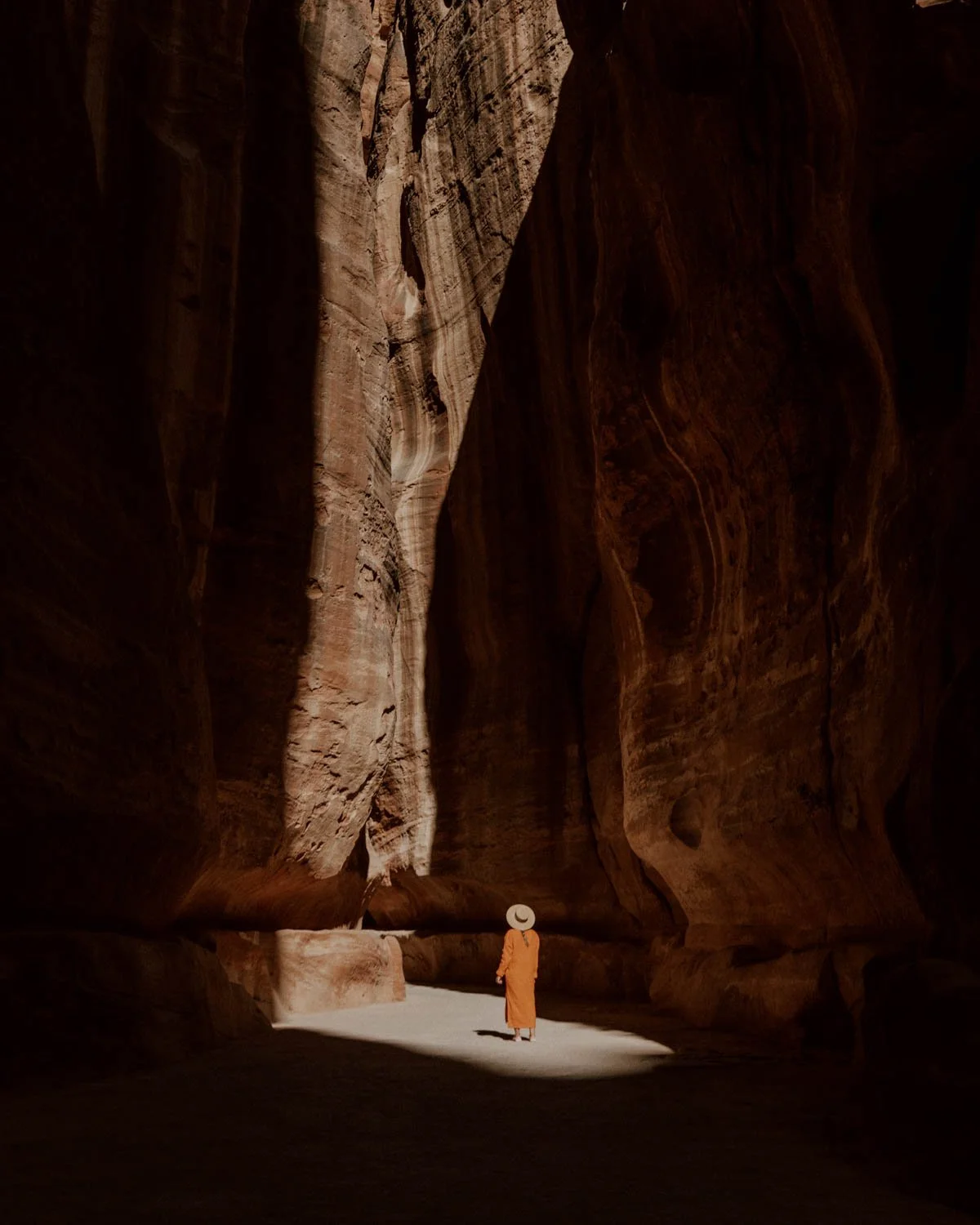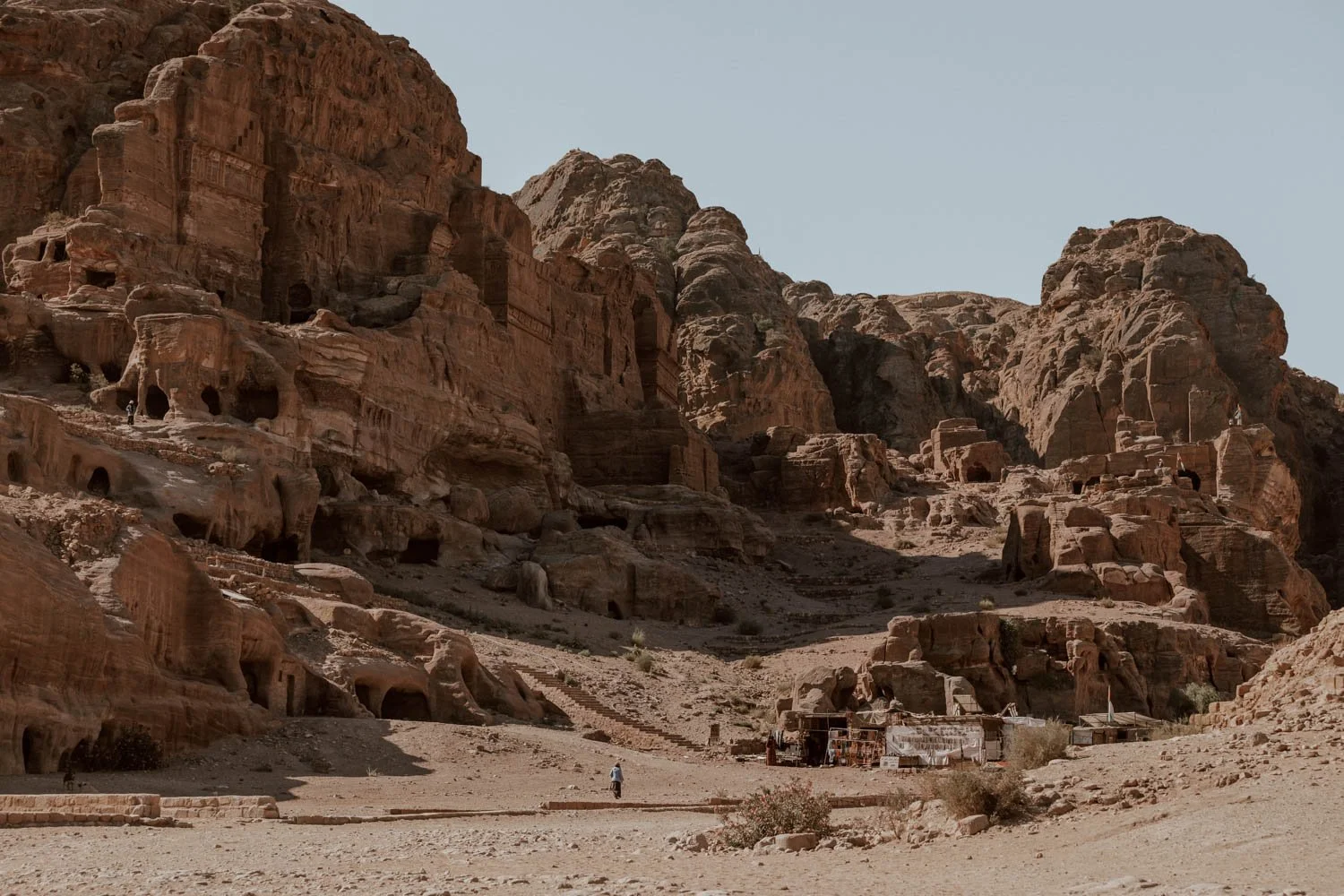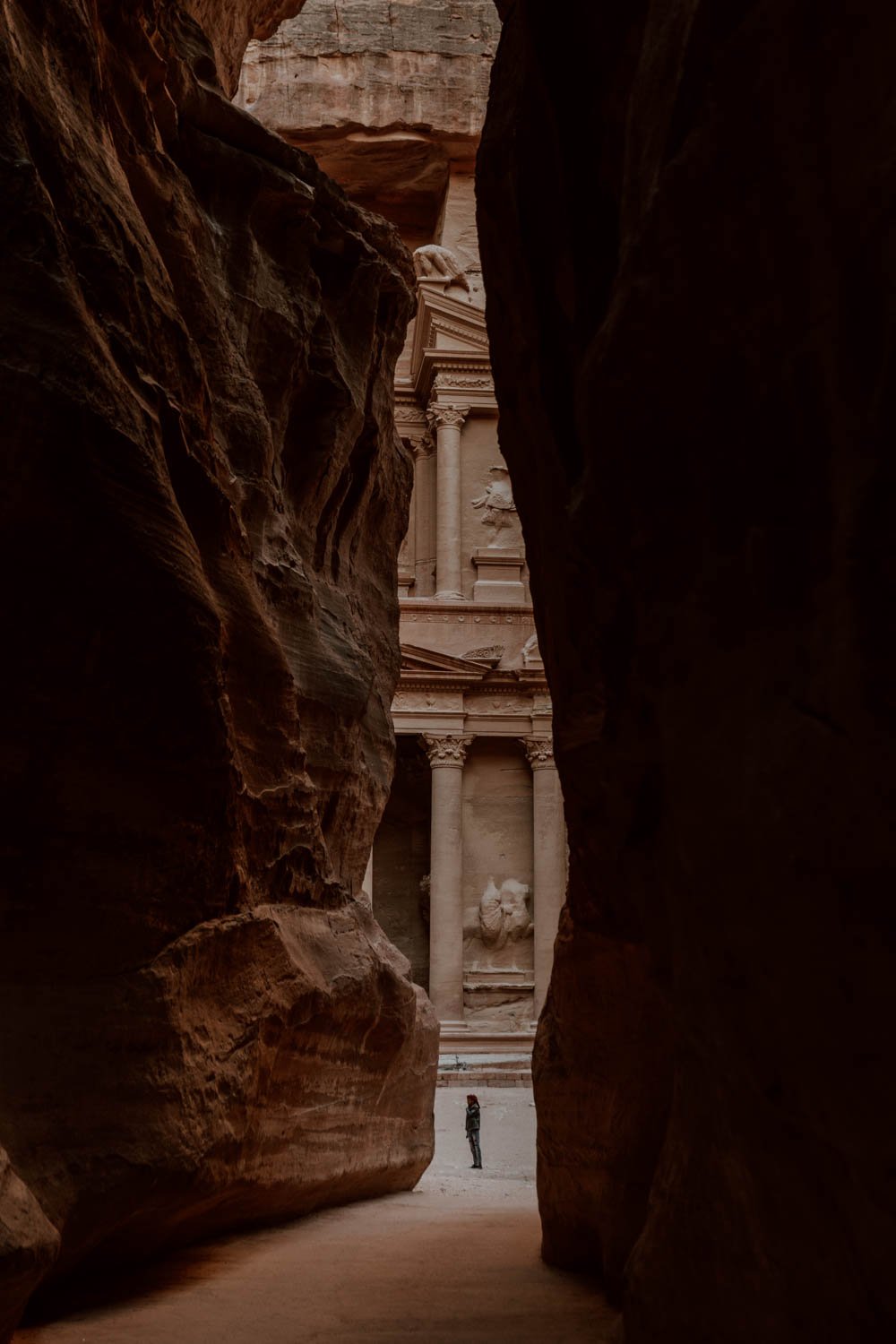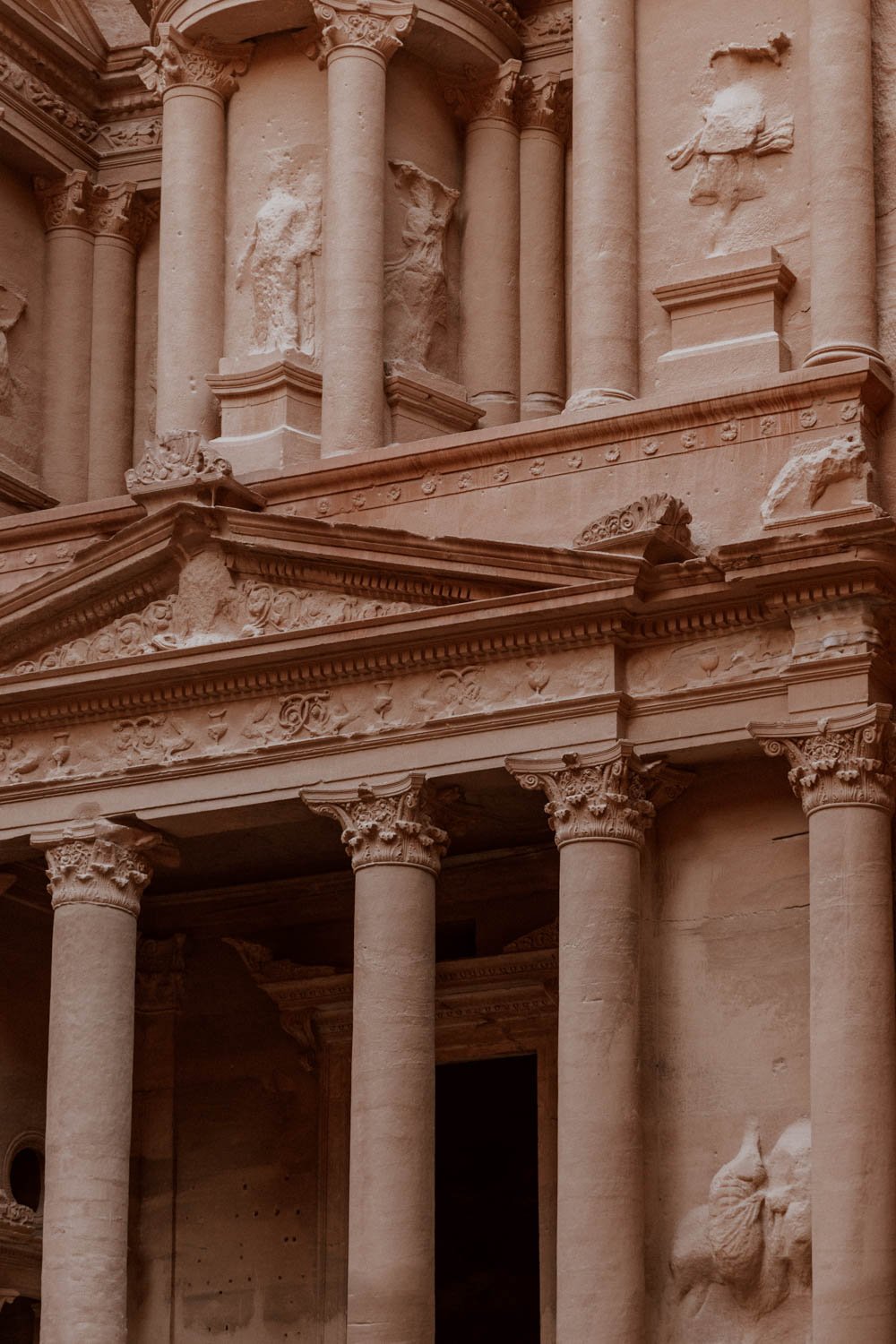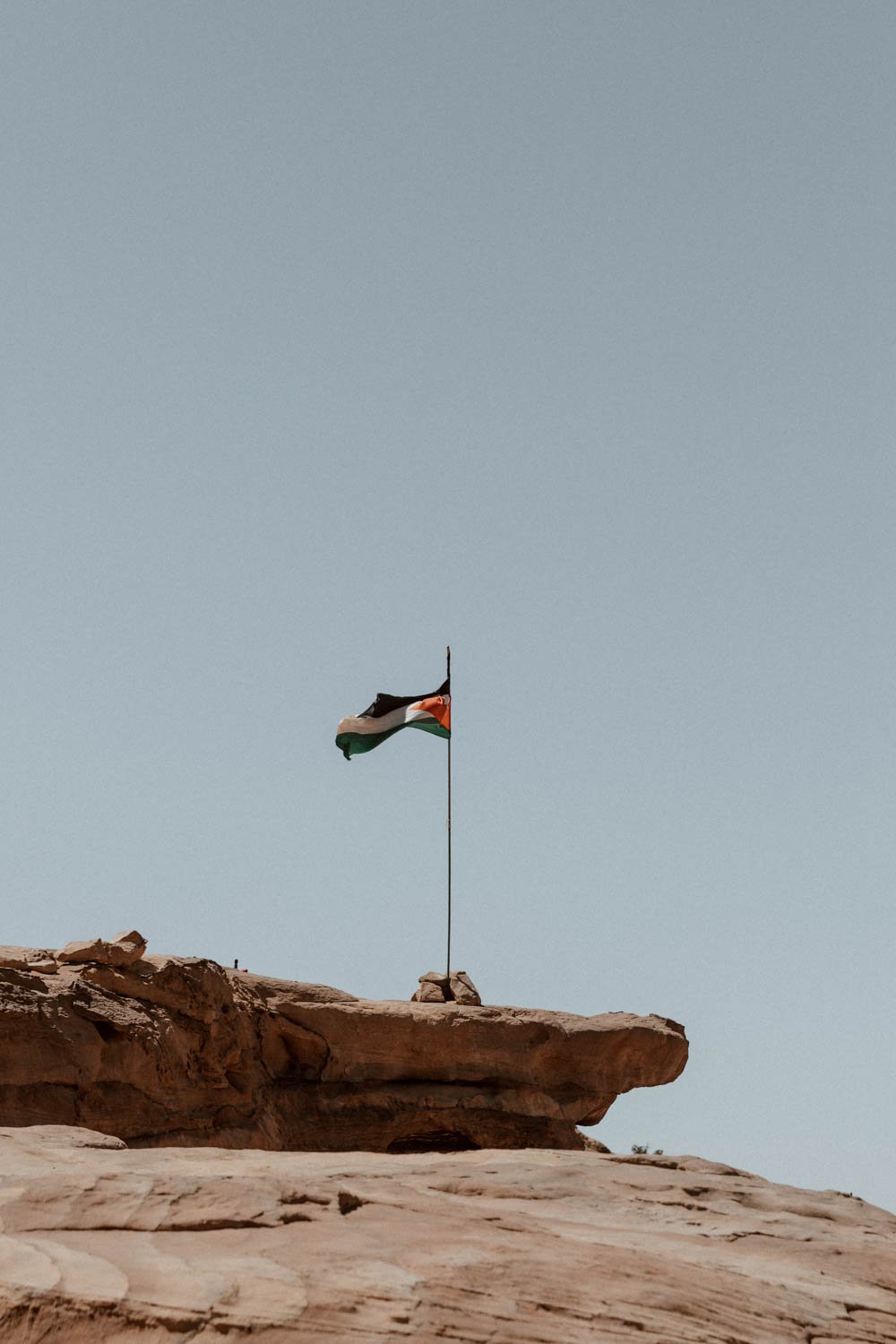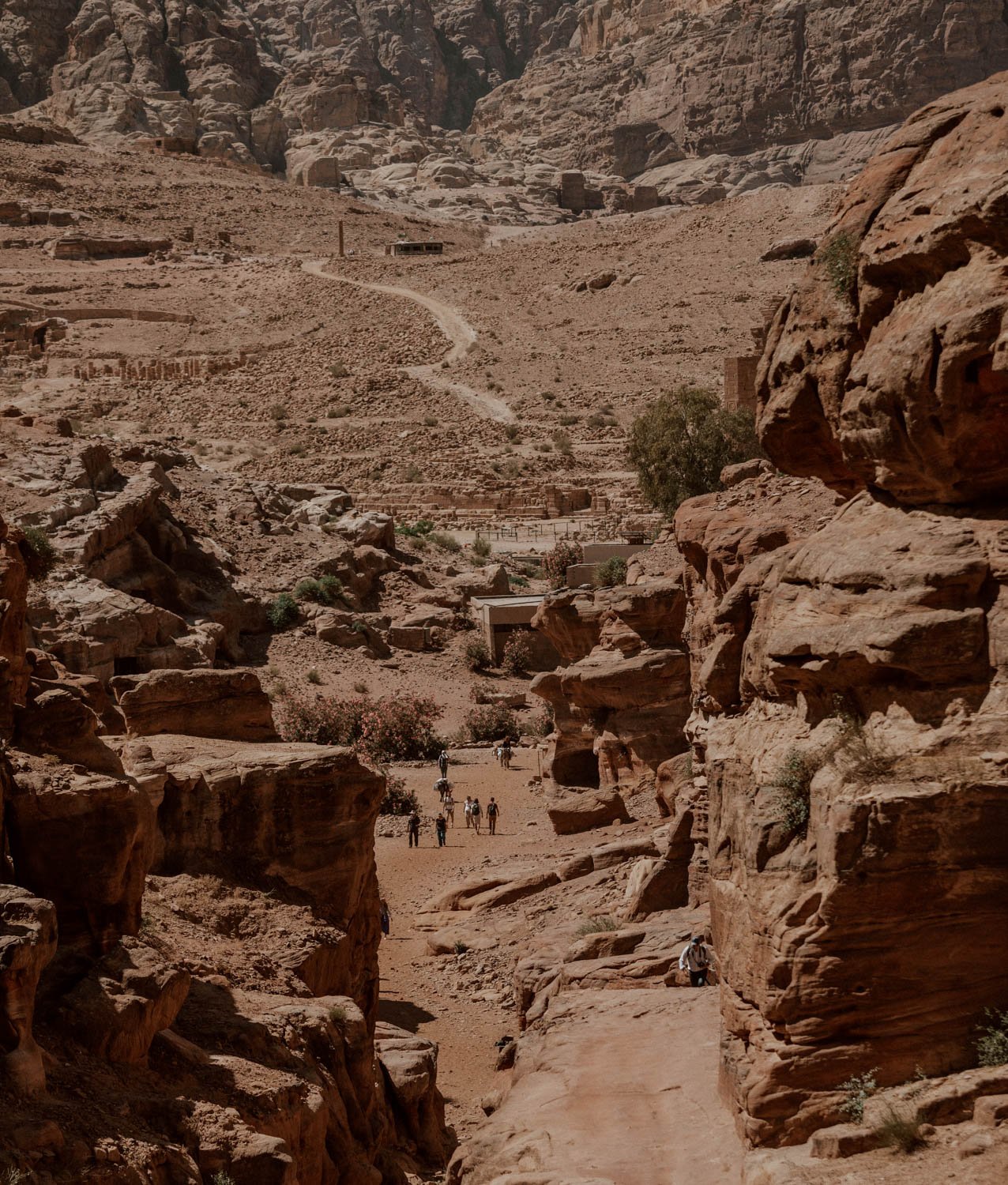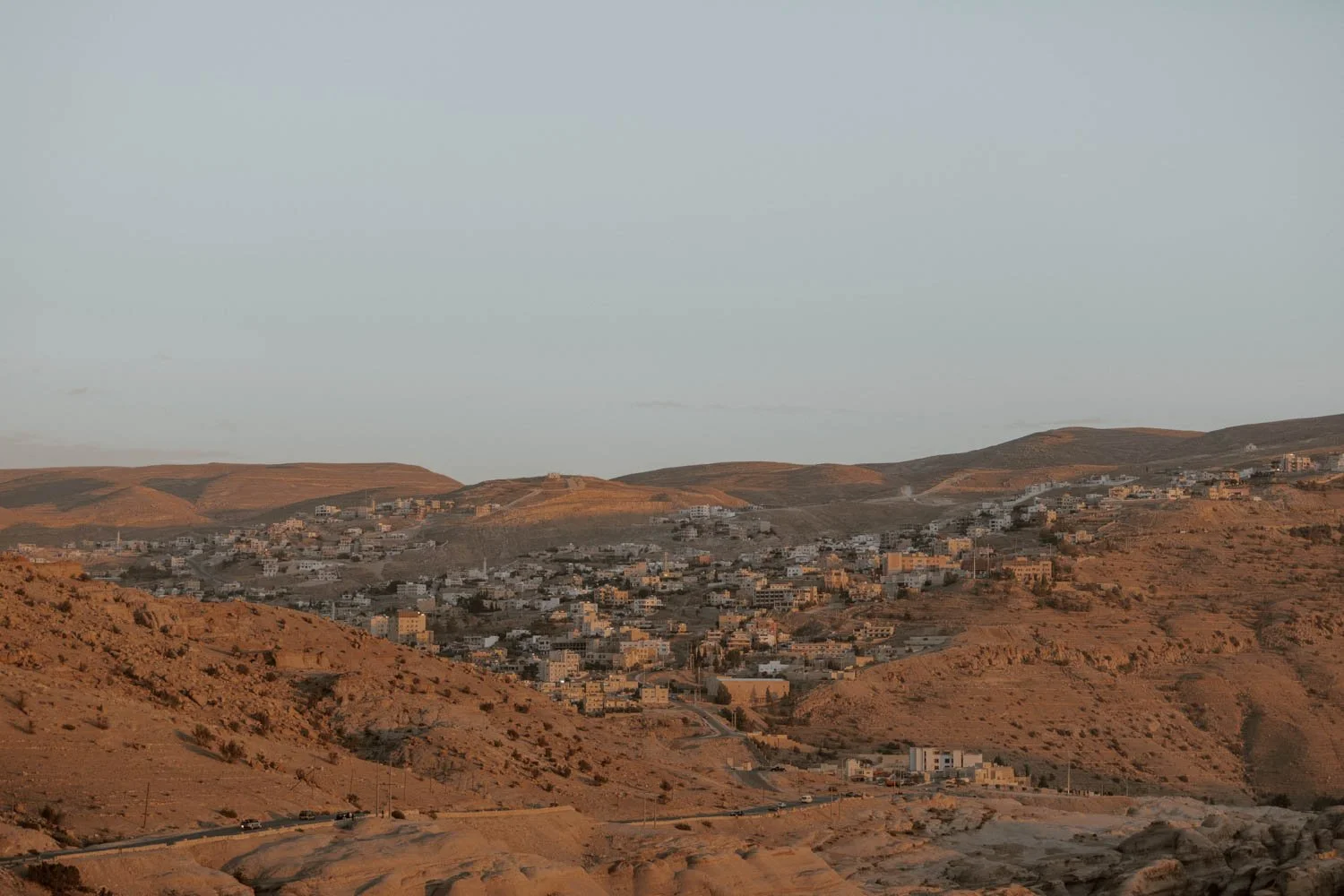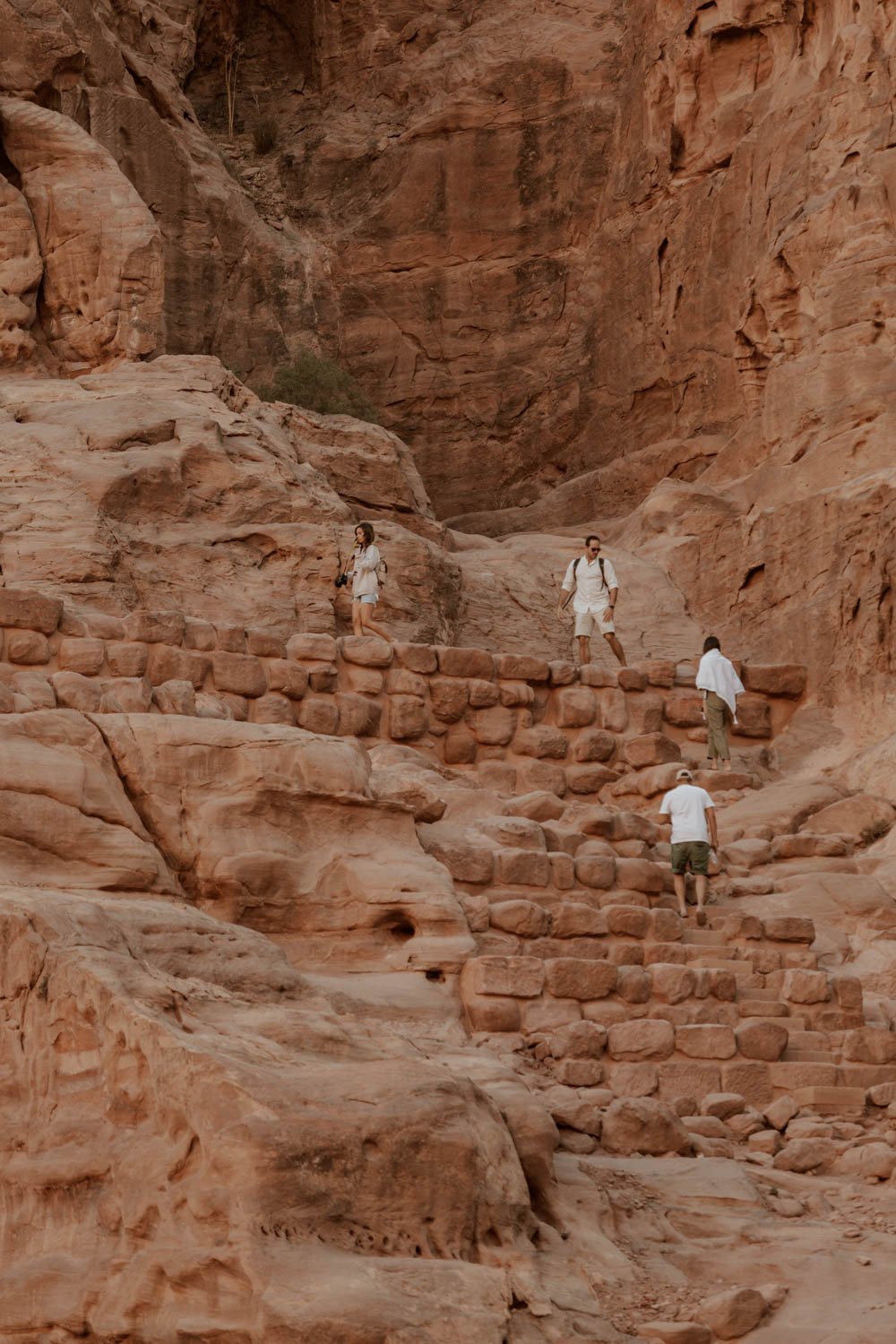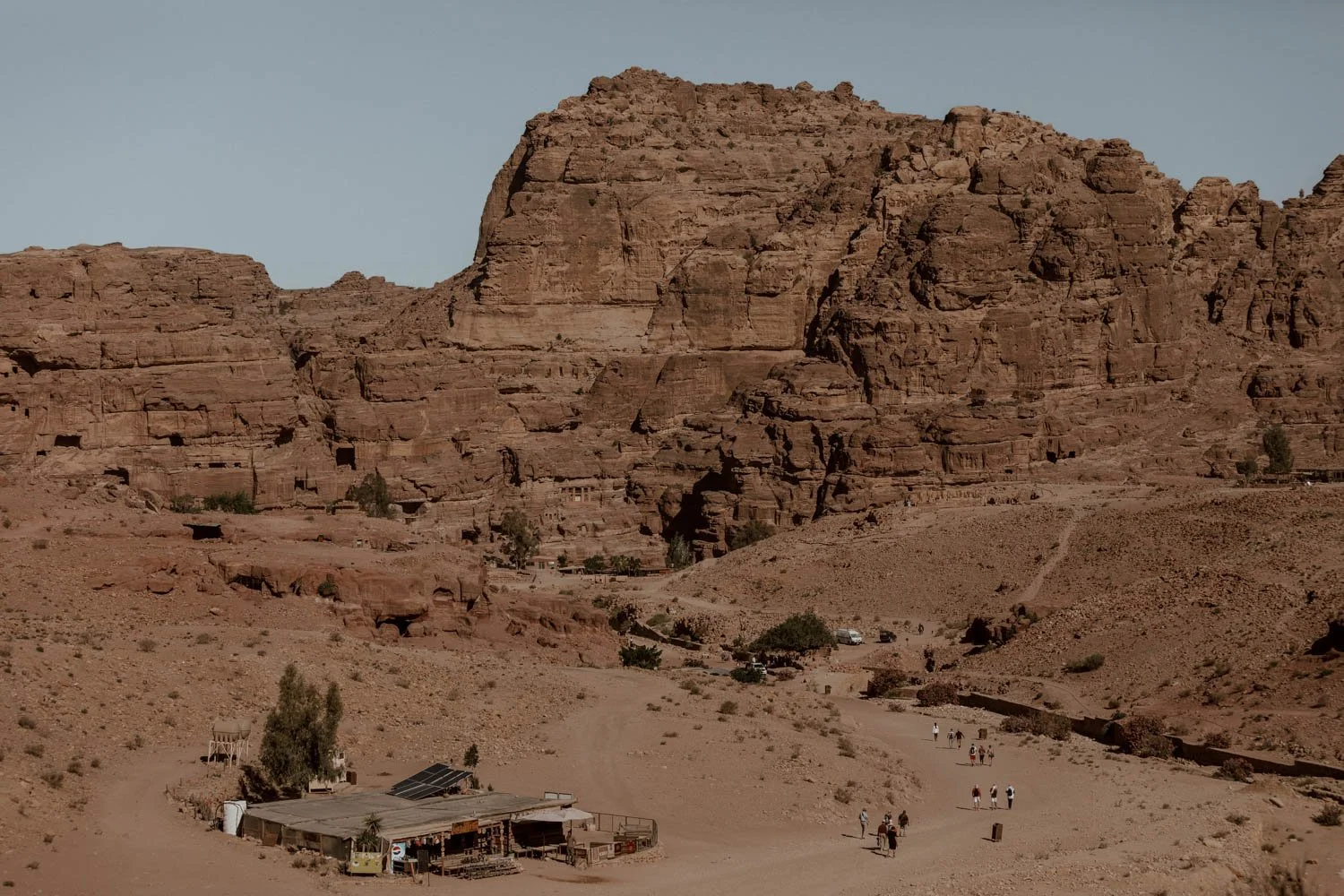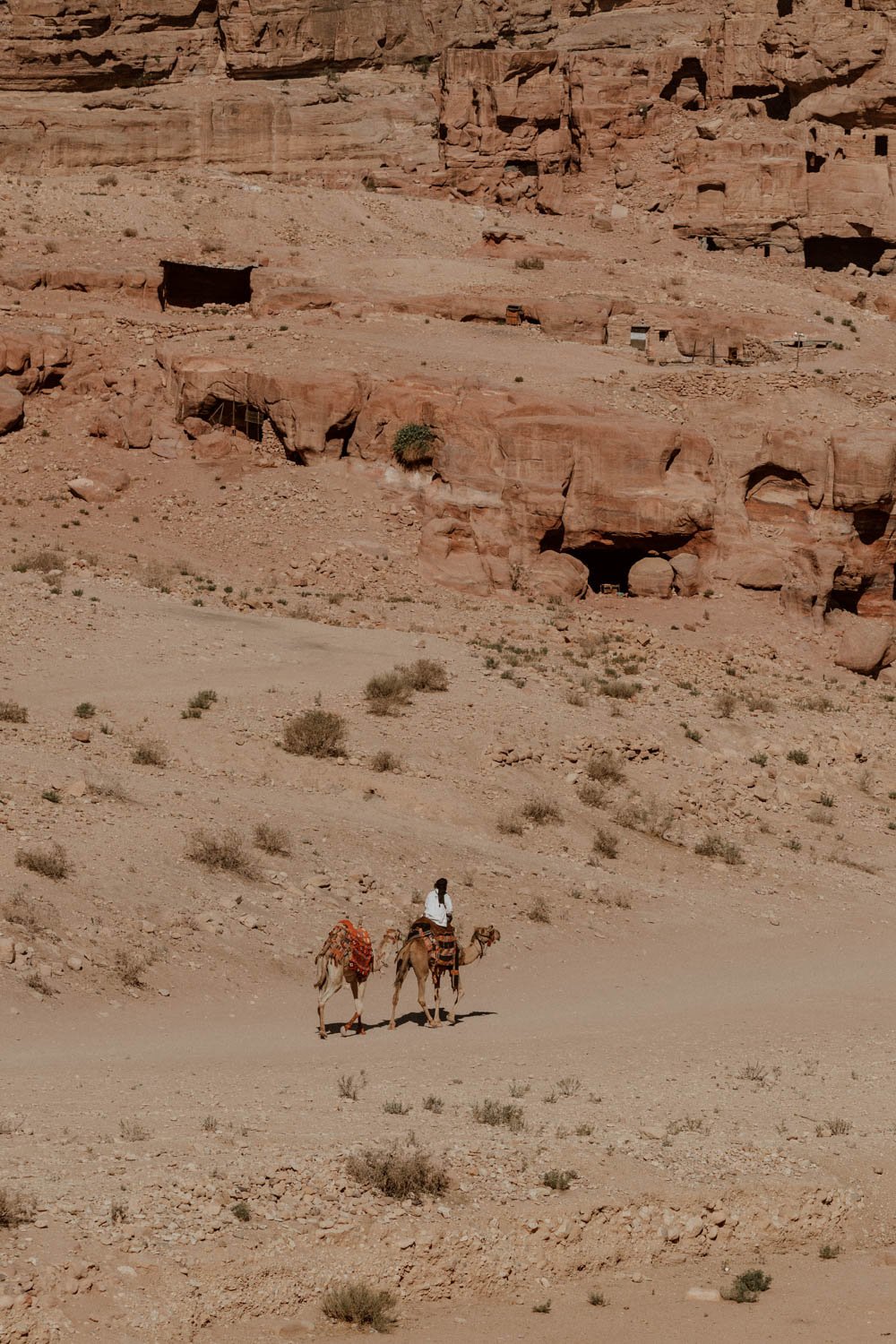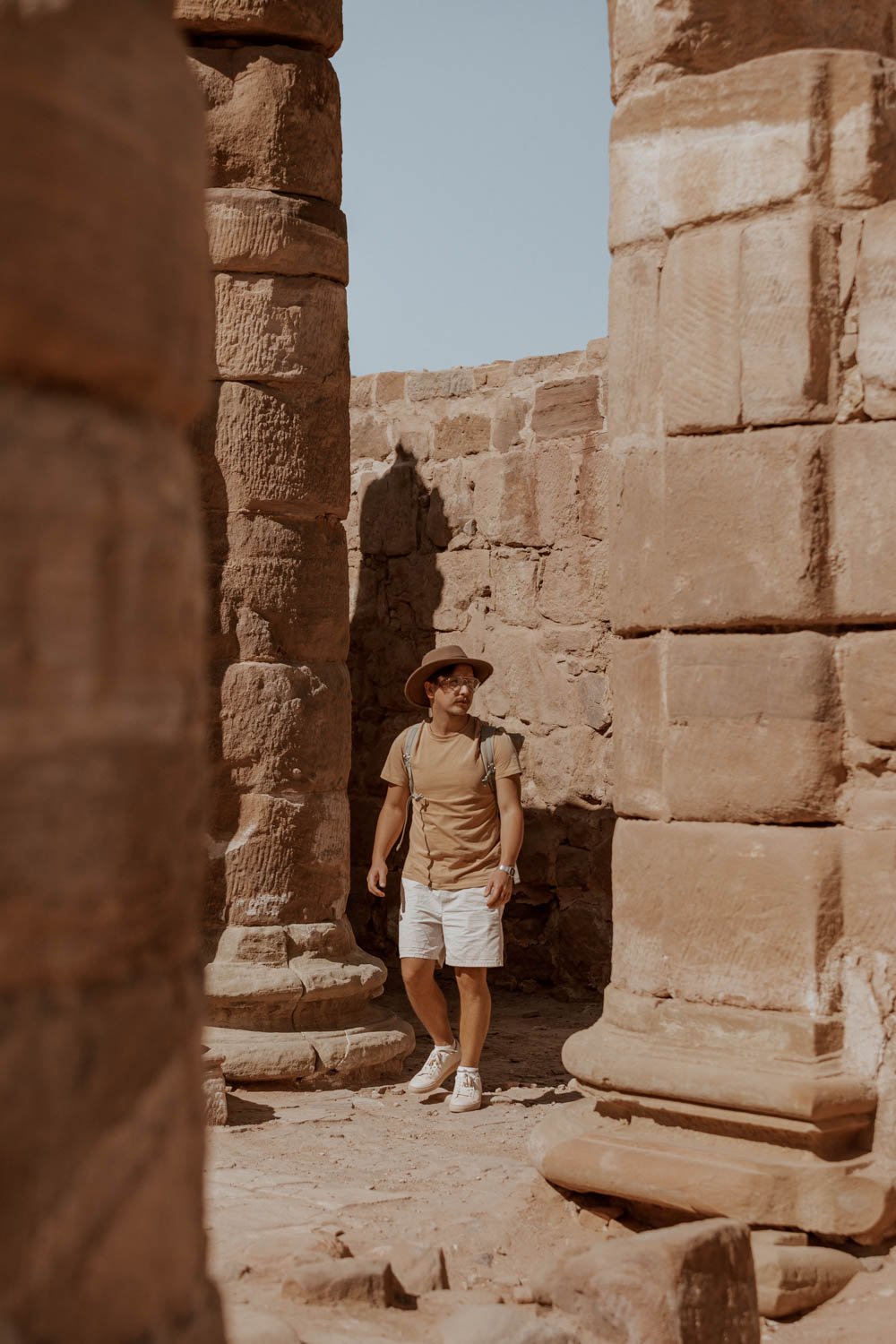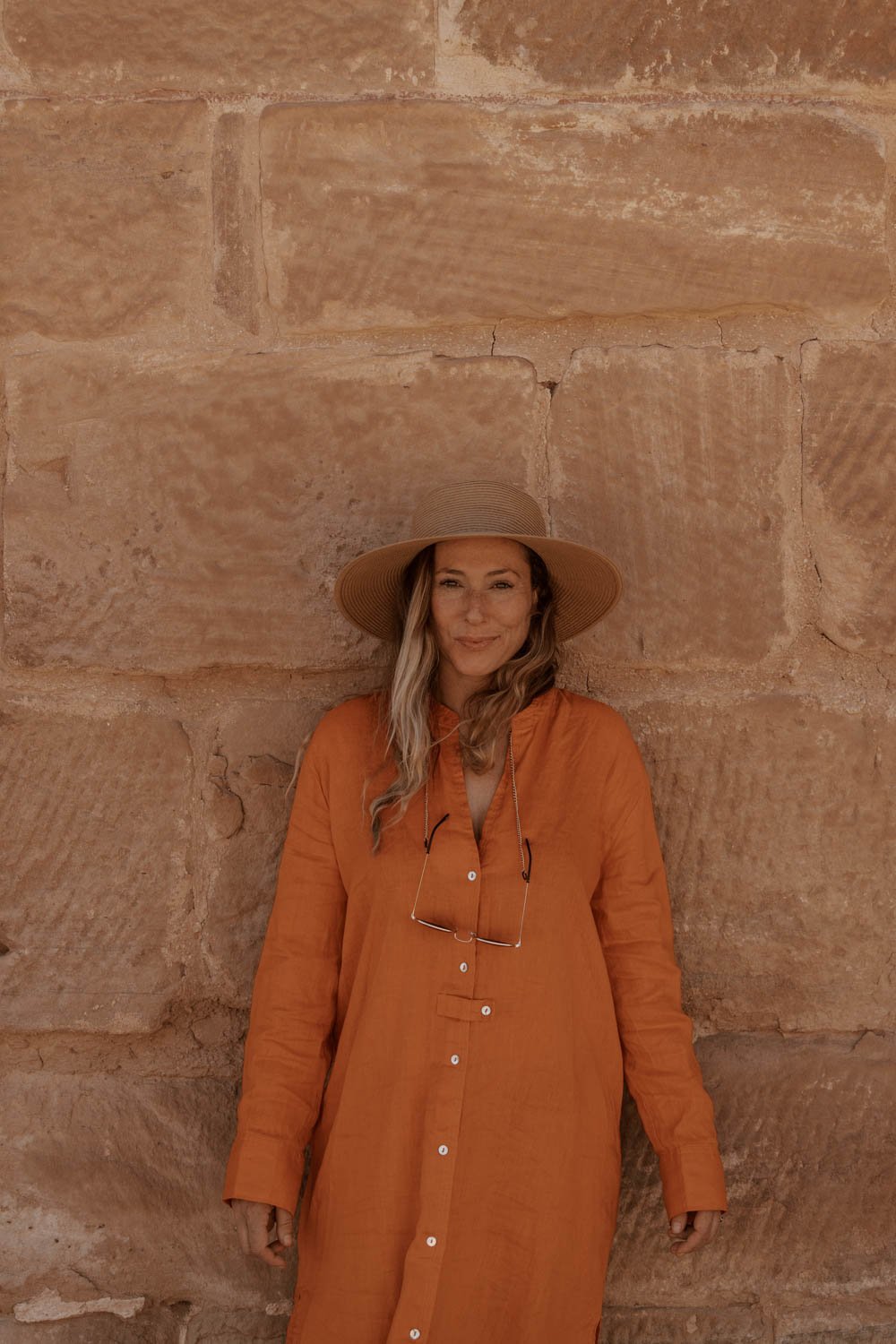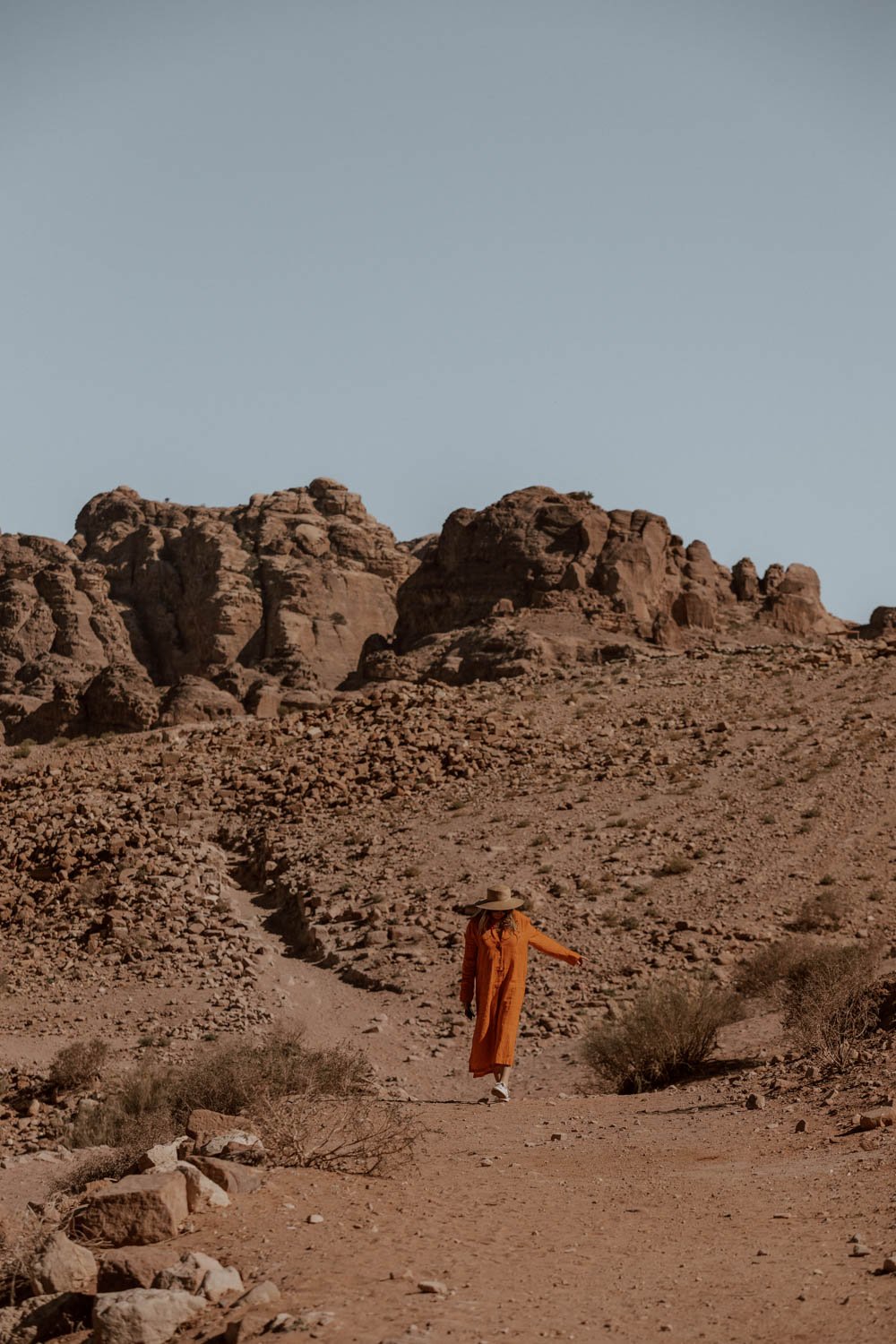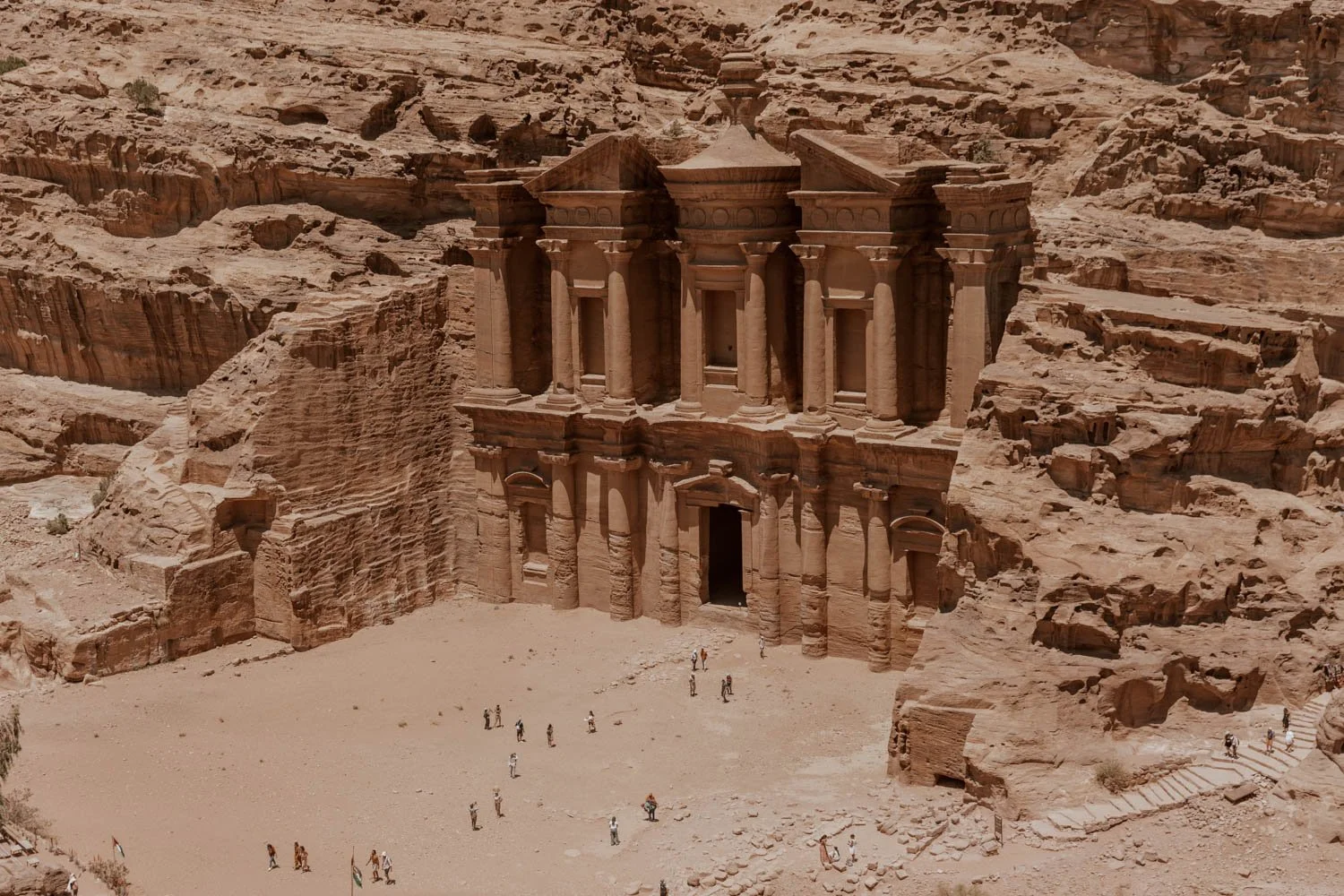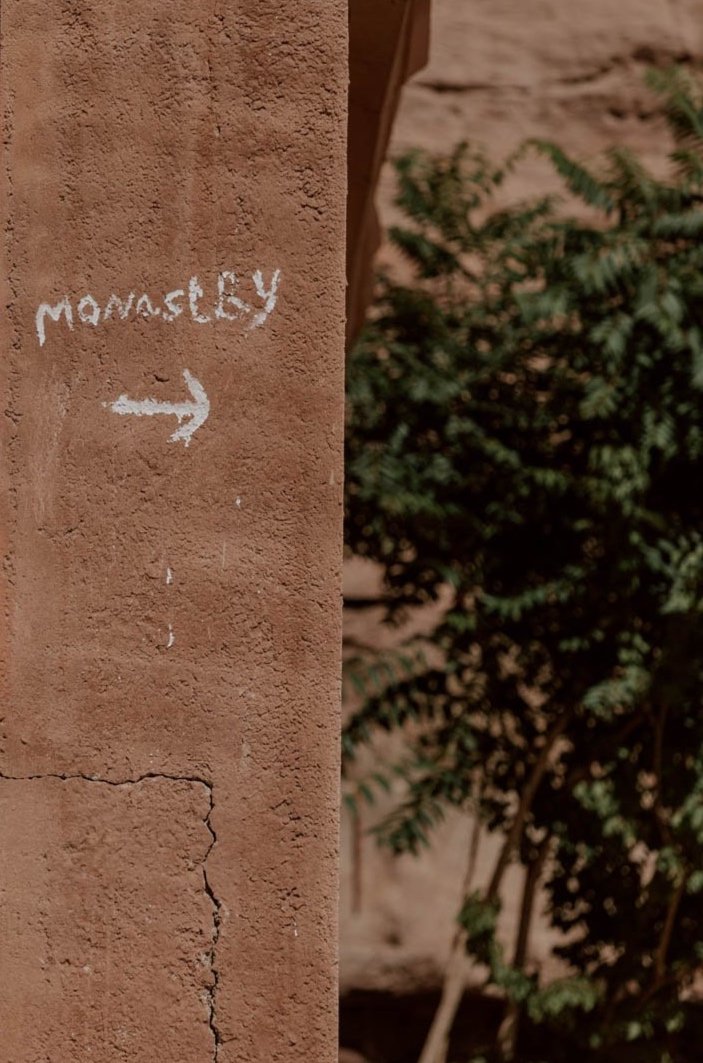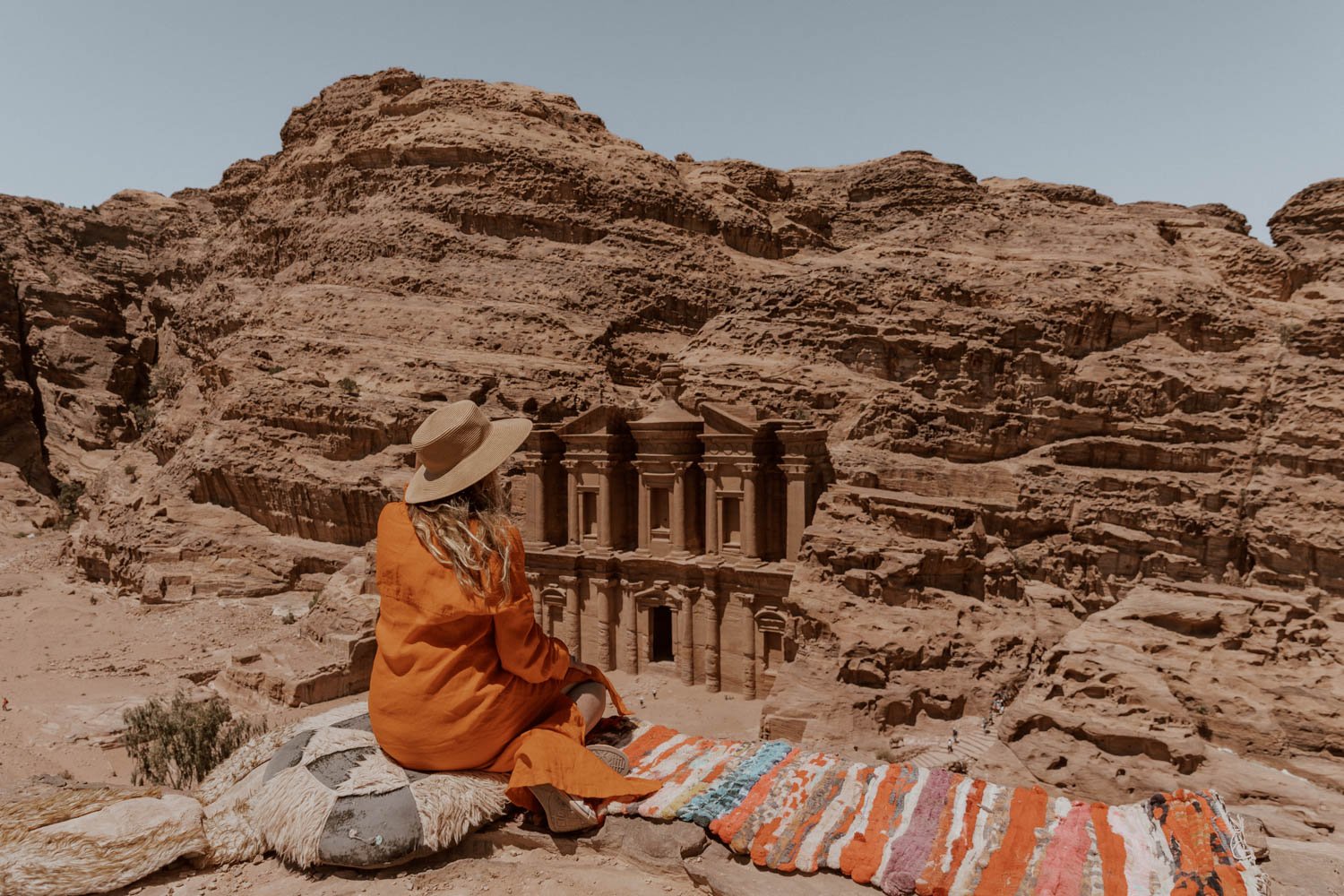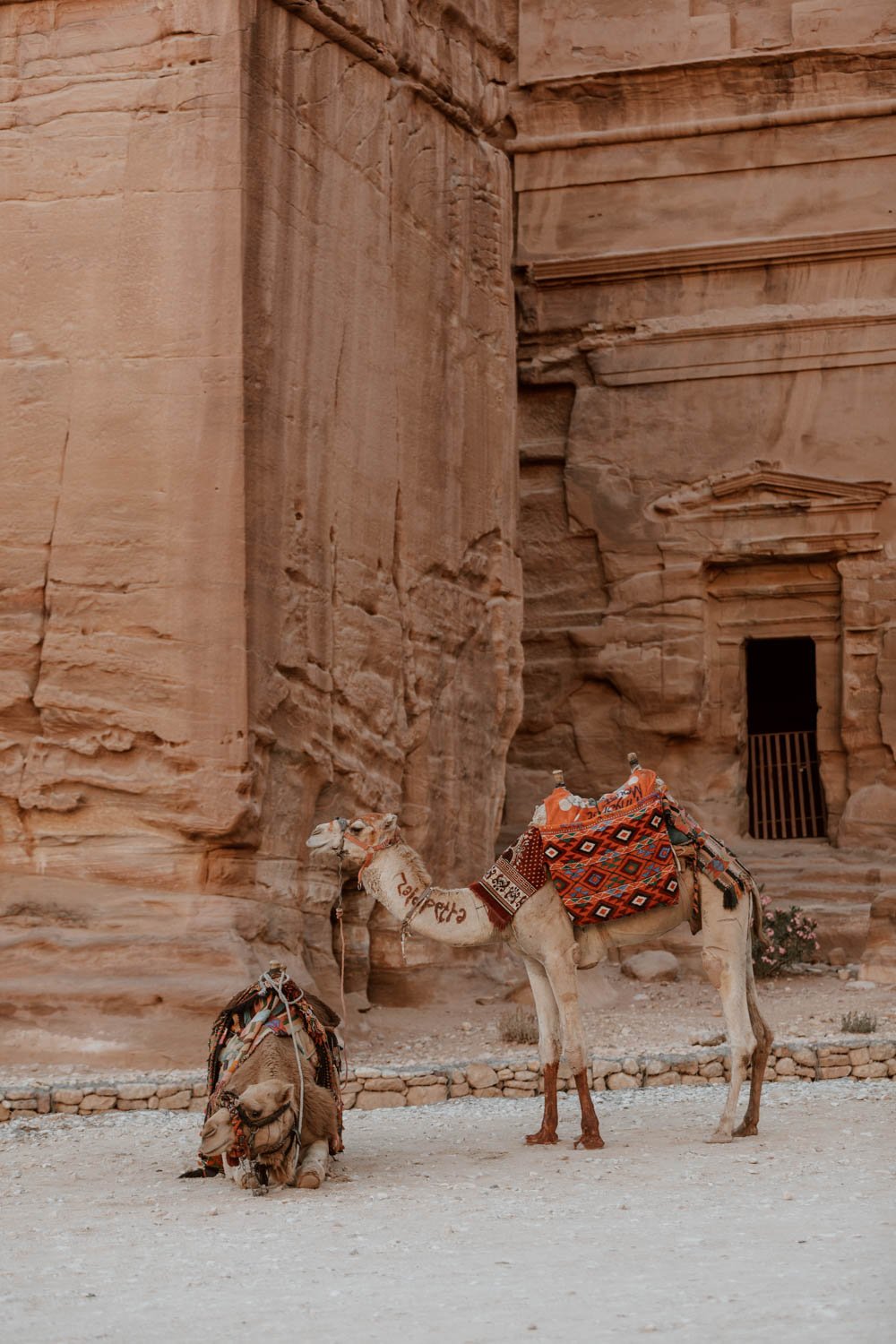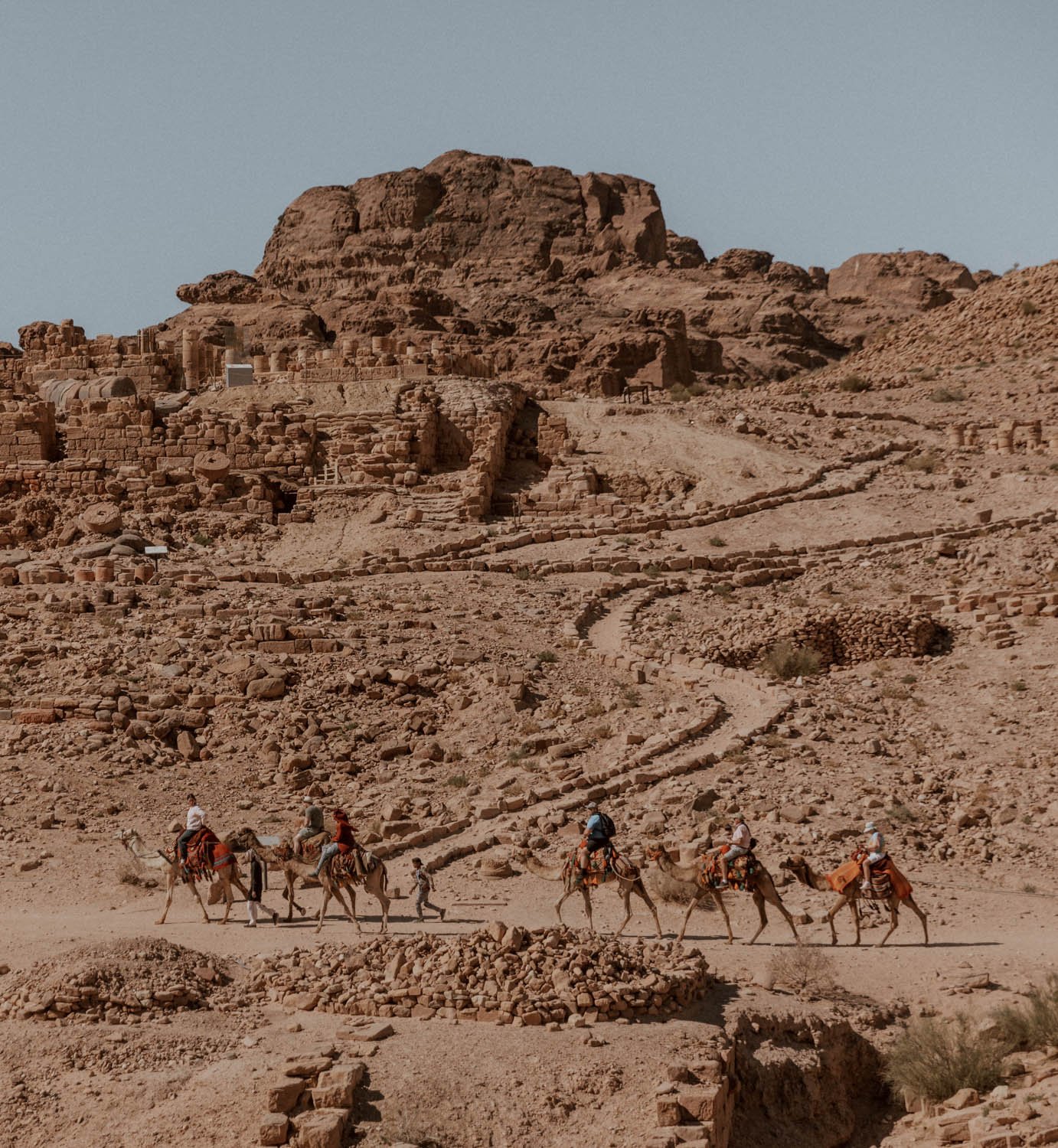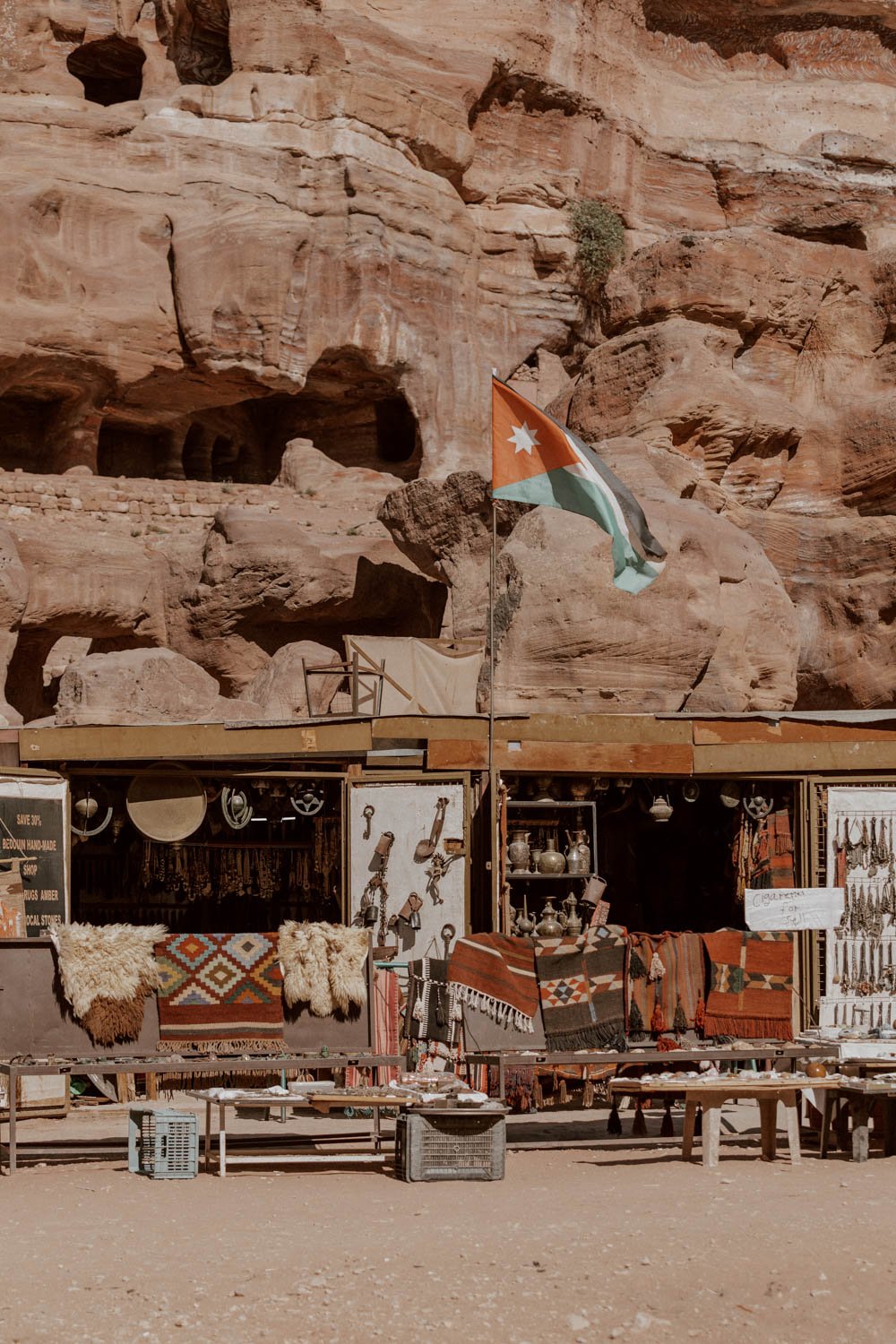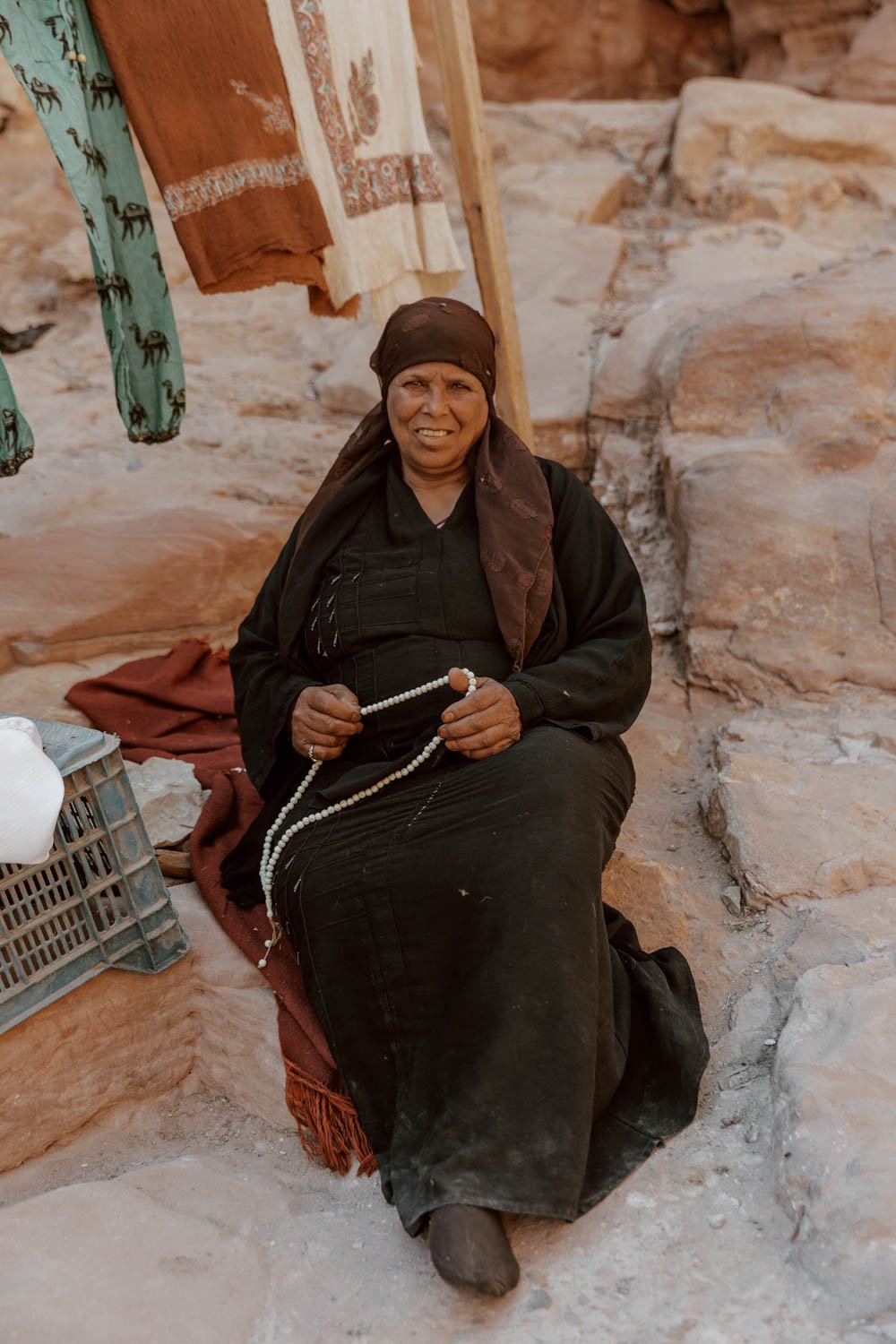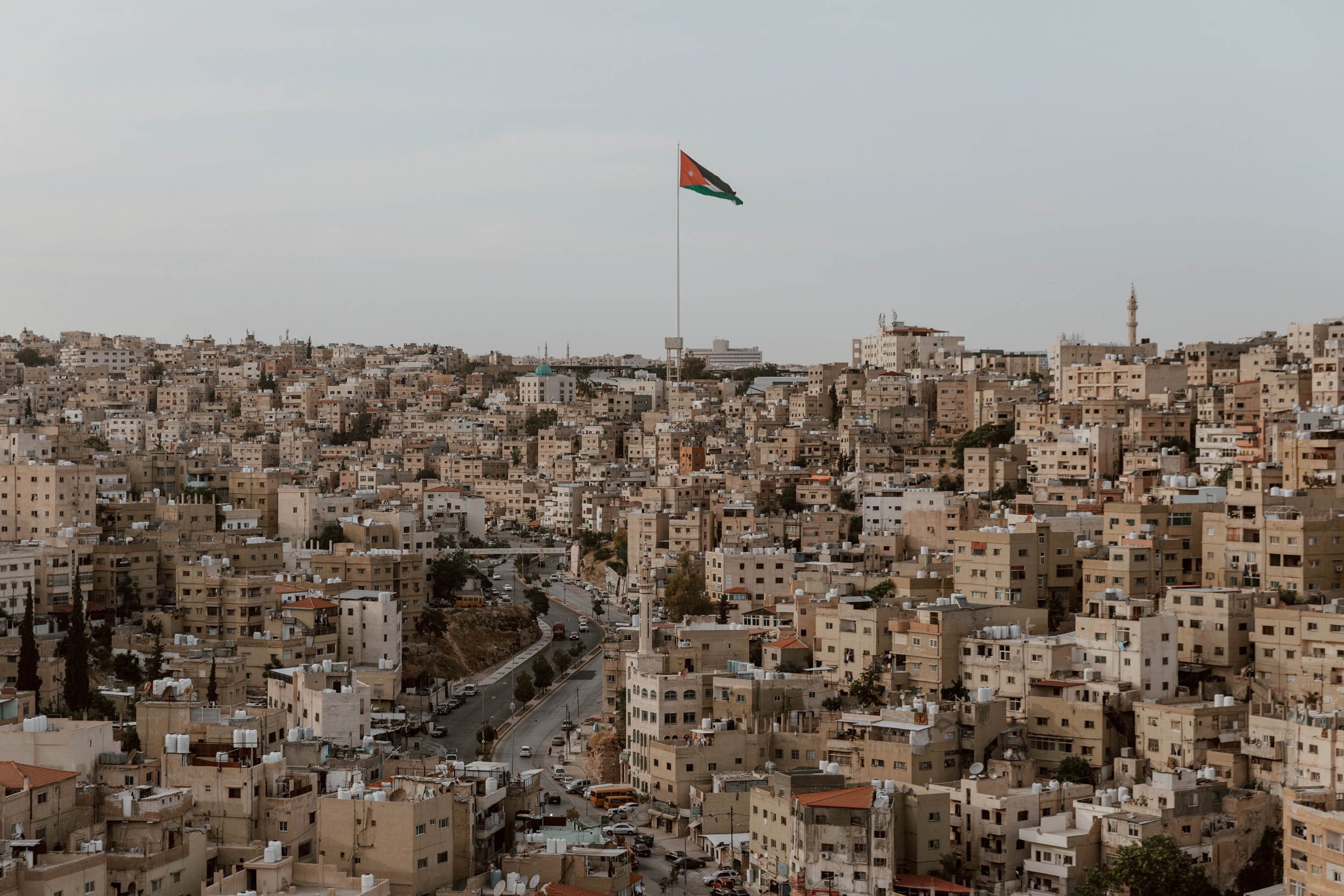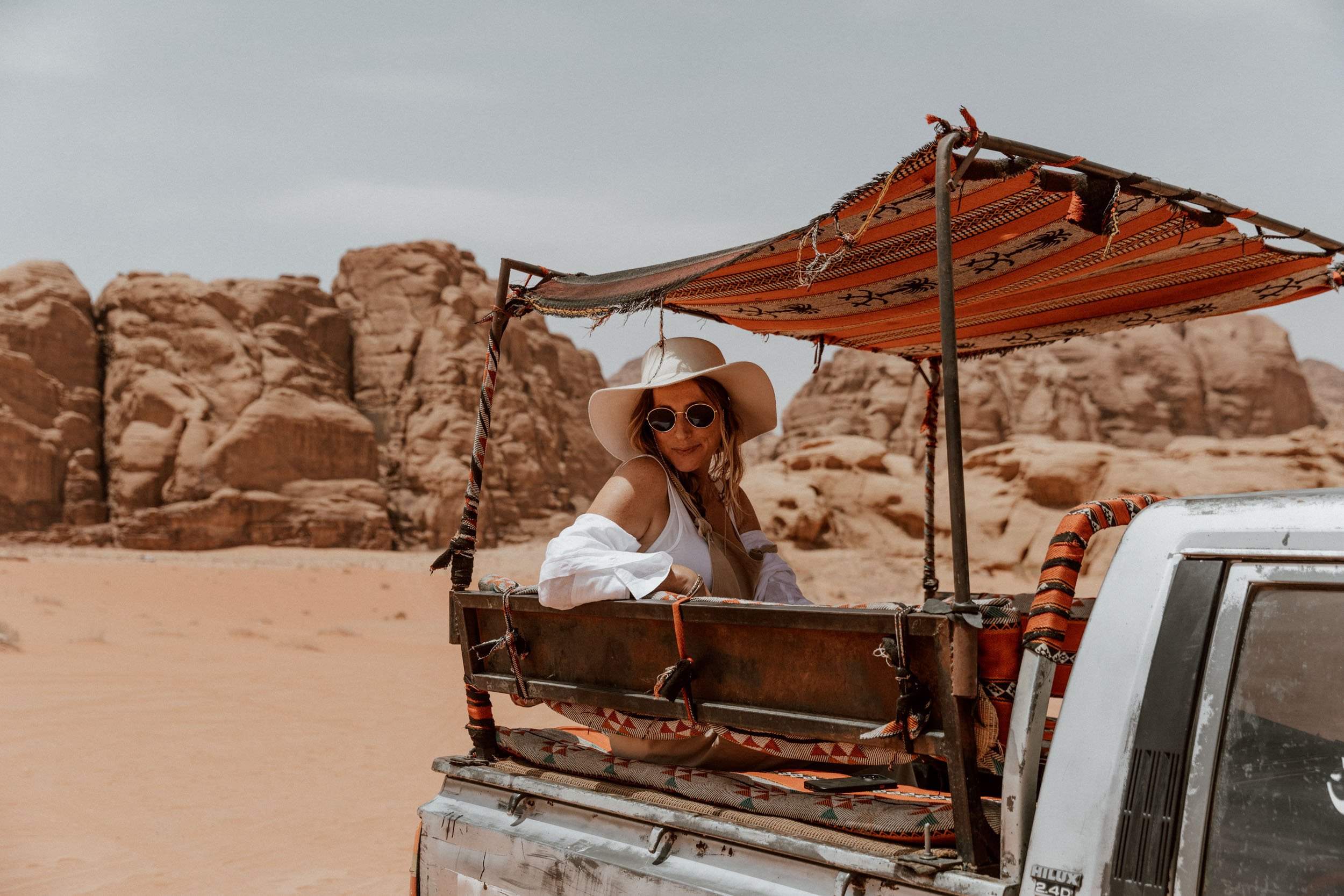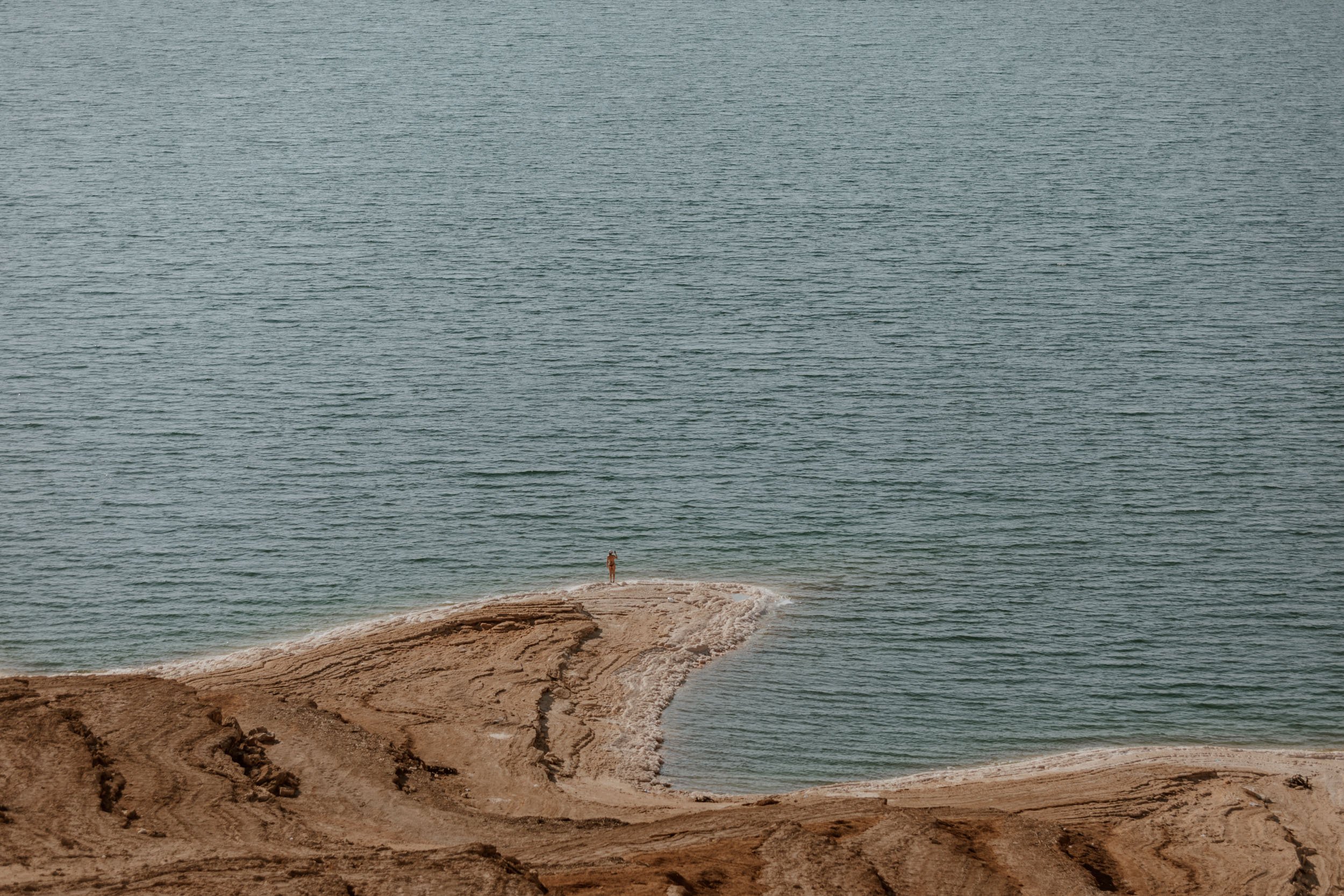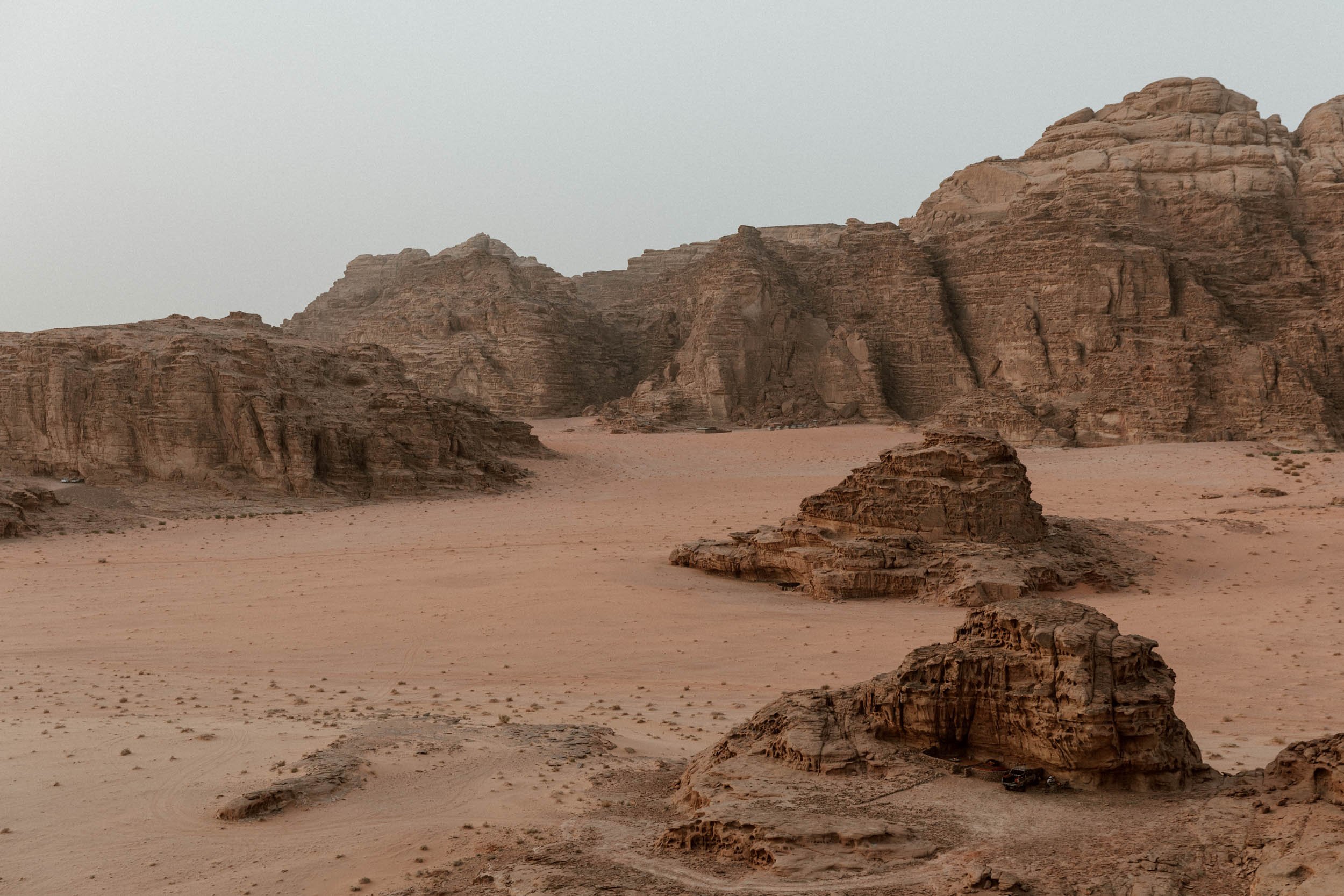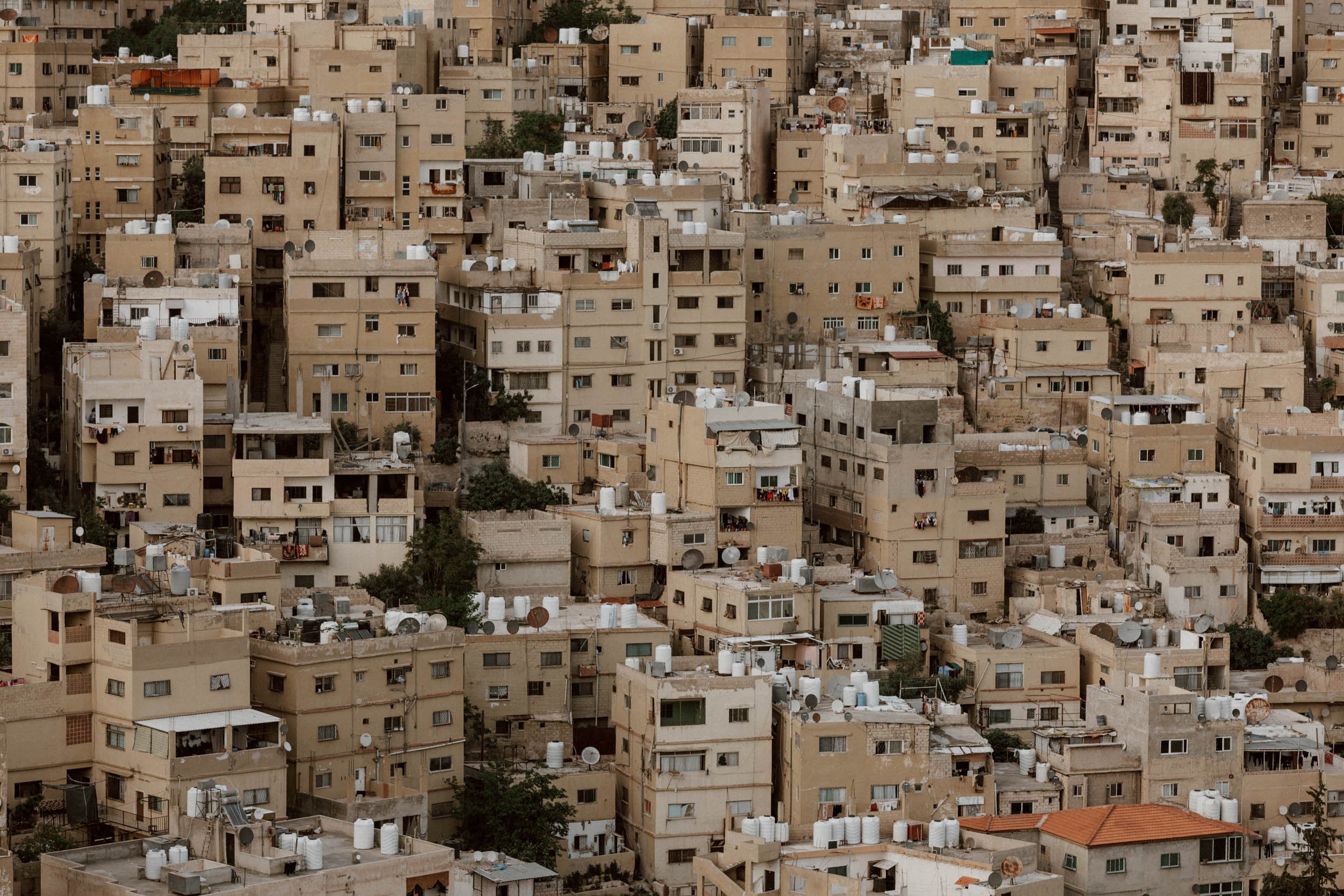“Match me such marvel save in Eastern clime,
A rose-red city half as old as time.”
If you're planning to visit Petra, the stunning ‘lost’ city in Jordan, our article will help you to get started and get sorted.
As well as providing the essential context and history of the site (without going into too much of the dull detail or spoiling the surprises!), this post will give you all the information, insight, and inspiration to perfectly plan your own Petra visit.
Importantly, as well as sharing honest perspectives on the good, the bad, and the ugly, we want to strip away some of the confusion, stress, and sense of overwhelm you may have around planning for Petra!
From insider travel tips, essential planning information, and the historical context you really need to know, we'll help you curate + create a more memorable experience of Jordan’s mysterious ‘New’ Wonder of The World.
This is our definitive guide to visiting Petra.
The Petra essentials
/ Ancient Nabataean capital, established 300-400 BC
/ In south Jordan, three hours from Amman.
/ Open year-round, from 6am to sunset.
/ 50 JD ($70/£57) for a standard one-day adult ticket.
/ 6-12 hours to experience highlights, two days ideal.
/ No accommodation inside, but lots in Wadi Musa.
THE CONTEXT | A QUICK HISTORY of PETRA
What’s So Special About Petra?
Forget the images you’ve seen.
Put the expectations to the side.
Dismiss the temptation to run ahead.
And instead, when first entering the sinewy, stretched helix of Petra’s Siq, try to imagine it’s another world, nearly three thousand years past; everything you know now is yet to be written, yet to be known.
You are a stranger in this land, led through the sand to a place where shadow-eyed men are said to disappear into the rock like sorcerers, and water flows are conjured out of dust and desert.
Though you are transporting treasures, whatever bargaining power you thought you held seeps away with each forward step deeper into the shadows of a hidden city carved into the rust-red rock.
In such a seemingly inhospitable environment, for today’s traveller it's hard to imagine life flourishing here in a dry waterless valley, let alone underpinning a thriving trade route for nearly a thousand years. And yet the treasures of lands and empires close and far-flung would have to cross the Nabatean kingdom and their capital, and to pay a price for their passage and protection.
Carvans loaded with cargos of spices, metals, scents, food and fabrics from the Mediterranean, Egypt and North Africa, Arabia, even goods from Indian and Asia’s Silk Road, were obliged to pass through on their way to or home on several key overland trading routes, and Petra was the nexus of several (think of it as a bit like the Panama Canal today).
On this, a fortune could be made for those who controlled the way; those who could provide shelter, water, and protection in the desert.
Petra, at the crossroads of several civilisations and a cosmopolitan power broker amongst them, was therefore an influential and well-known place in the ancient world; that it was effectively forgotten by history and outsiders for another thousand years is almost unbelievable.
Such mystery, and the fact that 85% of the site remains uncovered beneath the sands of time,is obviously part of its appeal. However, what takes most people’s breath away is the stunning imprint of the Nabateans upon the natural landscape.
The famous rock-cut facades of the Monastery and the Treasury, carved directly into the mountain from the top down, are the most captivating examples. But there are several other temples, equally beguiling, as well as the death tombs and the cave homes which pockmark the sandstone cliffs.
The Nabatean name was Raqmu, but it doesn’t take long to understand why the Greeks gave this city the name ‘Petra’, meaning rock, given how much of it seems to blend into or be created out of the natural landscape - a sort of negative architecture - than be built upon it or from it (though many of Petra’s free-standing buildings were lost to multiple earthquakes). Zooming out though, the whole of Petra constitutes a wider work of ancient art: swirls and lines in the soft, veined sandstone; the interplay of colours burning or softening with the shifting light creating several different Petras before you; the audacity of permanent human settlement and shaping in a setting which feels ephemeral, subject to the whims of winds and tremors of the earth.
Wander around with an open eye, and you’ll also note how deftly the Nabateans infused the cultures of those that passed through into their own architectural style, with vivid nods to the Greeks, the Romans, and the Egyptians all over in columns, reliefs, and pillars.
A walk through Petra across a day or three provides more questions than answers, more mysteries than epiphanies in the sand and dust. But succumbing to the mystery of how the rose-red city in the rocks came to be, and came to be forgotten, is a big part of the appeal.
There really is nowhere else like it.
Who Were The Nabataeans?
“They take refuge in the desert using this as a fortress; for it lacks water and cannot be crossed by other”
Very little is truly known about the Nabataeans, one of the most powerful pre-Christian and pre-Islamic tribes in the Middle East. First mention of them is in 312 BC, but if it weren’t for Greek and Roman sources, their story and society may well have been lost to the winds of time.
However, what is clear, is that the Nabataeans excelled at harnessing the harsh desert environment to their benefit.
With roots as nomadic shepherds, it’s believed they graduated from raiding trade caravans for spice and incense to taxing them for protection along the overland routes.
This pivot created a wealthy state by the 2nd century BC, with control of key trading territories in the Middle East and a desert fortress as its seat of power. As they settled, the nomadic aspects of their culture began to give way to agriculture, building, engineering works, as well as establishing themselves as commercial middle-men and merchants on route networks.
Petra, in unforgiving rocky, arid terrain, may not have appeared as the obvious choice for their capital and key income generator. However, for a people attuned to the harsh, drought-ridden environment, it had obvious natural strategic benefits, with the concealed, narrow entries and impenetrable topography in the valley giving an immediate upper hand over invaders and those depending on safe passage and hospitality. It’s status as a wealthy, thriving desert metropolis for nearly a millennia would however have been short-lived if the Nabataeans had not devised an innovative system of water capture, storage, pipes, and irrigation in the rock; remnants of this hydro-engineering systems trace the stretch of their influence across the region. Archaeologists have identified storage capacity for about 40 million litres - enough for 100,000 people - in Petra alone!
Today, who can be viewed as the direct descendants of the Nabateans is subject to debate as they sort of disappeared from the history books alongside their capital, but this article is the most in-depth investigation we found.
The Rise + Fall of Petra
The growing power and influence of the Nabateans over a nexus of trade routes brought threats as well as opportunities. Their Seleucid northern neighbours, a Greek state, successfully invaded in 312 BC, but were so weighed down by their loot that the Nabateans overran them as they departed.
It was the Romans though, establishing the borders of their own empire in the Middle East, who would eventually gain control of Petra. Tensions had built between the two sides for over a century, but it was the culmination of a series of bad political bets by Nabatean Kings, rather than blood and battle, which saw the wider Nabatean Kingdom folded into the western fringes of the Roman Empire in 106 AD.
Petra was now the capital of Arabia Petraea and, far from sounding the death knell for Petra, this led to a flourishing of commerce and cultural exchange over two centuries. The population of the capital increased to about 30,000, and the Roman influence is responsible for a number of the most prized architectural works in the city.
Petra’s decline is therefore based on two factors: 1) a huge earthquake in 363 AD thought to have ruined almost half of the city; 2) a rise in sea trade reducing the profitability and use of overland caravan routes. Following a period of Islamic rule and more damaging earthquakes, its population scatted and it was effectively abandoned in the 7th century.
The Rediscovery
Somehow, beyond myths and half-forgotten stories, the caves and tombs of Petra were pretty much forgotten by the world and left silently to nature and nomadic communities.
It was the intervention of a young Swiss adventurer-scholar - fluent in Arabic, a convert to Islam and disguised as as Sheikh on pilgrimage - which changed everything. Johann Ludwig Burckhardt, who lived about five remarkable lives in his thirty-two short years, heard rumours of ancient ruins in a narrow valley on his overland odyssey in the Middle East in 1812. Adopting his persona of Sheikh Ibrahim Ibn Abdallah, claiming to his guide that he hoped to visit the grave of Moses’ brother (Aaron / Haroun) and sacrifice a goat there, he is credited as the first western traveller in centuries to have set foot in Petra.
His writings led to the first arrivals of academics and archaeologists in the early 20th century, and tourism followed in small numbers until a the desert highway was completed between Amman and Aqaba in the 1960s. Although Petra was declared a UNESCO World Heritage site in 1985, and featured prominently in Indiana Jones and the Last Crusade in 1989, the explosion in modern-day tourism here and in Jordan more generally took place due to the signing of the 1994 Peace Treaty between Israel and Jordan, which created a level of stability in the conflict-torn region. The number of visitors to Petra more than doubled in a single year after that, and now hits over a million per year.
Its development as one of the world’s largest tourist sites has not been without controversy though. Due to its UNESCO designation, the Jordanian government began to force families of the Bdoul tribe out of Petra and into a newly constructed village nearby. The shift from caves to concrete was welcomed by some, but resisted by others, and it’s thought that about 20 or so families returned to stay within Petra. The Bdoul tribe constitute the majority of the people selling souvenirs and working inside.
Burckhardt didn’t survive to realise the magnitude of his ‘rediscovery’ of Petra, dying in relative obscurity just five years later, buried as a Muslim under his adopted identity, almost as forgotten as the rose-red city he brought back to the world.
The Practical | Plan For A Petra Visit
ALL ROADS LEADS TO WADI MUSA
The small town of Wadi Musa (Google Maps) is the entry / exit point for Petra, and most of you will spend at least one night there (there are a lot of wadis in Jordan, and this is not the same place as the otherworldly Wadi Rum desert).
Typical travel times to Wadi Musa by car along the quickest route (not the King's Highway!) are: Amman (3.5 hours); Madaba (3 hours); Dead Sea (3 hours); Wadi Rum (2 hours); Aqaba (2 hours).
As Petra will be a central part of your Jordan itinerary, we recommend getting an idea of where you’ll be before and after early in the planning / booking process.
Note that, if you have a rental car, you can do Petra as a day trip from any of the above but we personally wouldn’t recommend it from Amman, Madaba or the Dead Sea: the round-trip drive is too long, and you’d be much better spending the night in Wadi Musa.
Public transport to/from Wadi Musa is limited, meaning those without a rental car travelling from the above destinations in Jordan, are usually best to take a private taxi or a tour for a day trip.
For independent travellers, there is however the JETT bus, which has daily departures from Amman and Aqaba.
In terms of parking for day trips, the best option is the large free car park near Petra Moon Hotel (find it here - this is also where you catch the JETT bus). If you arrive later in the day and the car park is full, you could alternatively look for on-street parking in the close vicinity or try this free car park, a couple of minutes walk away.
We’ve put together a short guide on how to get to Petra (published soon), so recommend giving it a read if planning on visiting independently.
Read Later | 17 Things To Know Before Driving in Jordan
How Long Do You Really Need For Petra?
You may have read that one day is absolutely not enough for Petra.
We think there needs to be a bit more nuance than that.
If you're hoping to become intimately au fait with Petra, have a passion for its historical and archaeological importance, or just want to walk as many of its ancient paths as possible, then one day will not be enough. It covers a large area (about 60 square kilometres, quarter the size of Edinburgh), and we have a few followers who spent three days exploring the site and its spider-web trails amongst the honeycomb caves, and know some people who have visited multiple times for multiple days.
But does that mean every traveller's Jordan itinerary should commit two or three days to visiting Petra?
Absolutely not.
On our first day visiting Petra in the middle of May, we were there from 6am to 6pm. We always like to start early to avoid the crowds, but lots of blogs and the Lonely Planet had been so insistent about the vastness of the site, that we thought we'd hardly scratch the surface across those 12 hours.
That wasn't the case: we lingered and wandered slowly, had ample time within the contours of the Siq, investigated the tombs and caves of the colonnaded street, walked on some random trails for viewpoints, and then walked up the hundreds of steps to the Monastery, before hanging out there for a few hours, walking back down, and retracing our steps and admiring the different light and perspectives.
In other words, in that twelve hours we had time to savour most of the 'unmissables' of Petra’* at an unhurried pace.
We also returned for a few hours the following morning, but that first full-day would definitely have been the dream experience for some of you.
Therefore, we think the most important thing to know in advance is that you can have a fantastic, meaningful experience of Petra in a single day if that day consists of 8-12 hours from entrance to exit.
And therein lies the rub: many Petra day trips or tours won't allow you even half that time (we’ll explain those a little bit later in the post).
If you're based in Wadi Musa and fit and eager enough to do what we did, one day may just be perfect for you. However, we fully appreciate that spending that amount of time walking under the Jordanian sun may not be enjoyable for everyone. Indeed, walking 15km+ in a single day may not be realistic or practical.
Alternatively, you may to prefer to focus in-depth on one area, or only spend the morning or late afternoon out and about, then rest up back at your accommodation. Perhaps you wish to spread out your awe and appreciation, or to return the following day with perspective and better understanding (especially after popping in to the excellent free museum in Wadi Musa). Maybe you're allergic to 6am starts or heading all the way up to the Monastery is something you wish to undertake as a single activity, rather than patching it on to everything else Petra has in store, or you realise that you really would like to do one or two of the trails after all.
In that case, spreading the experience over two days is going to allow you to explore at a pace which suits you and the opportunity to meaningfully see more.
However you apportion your time, we recommend all independent travellers purchase the two-day Petra ticket as it allows you the choice and flexibility to choose - rather than setting up a moment of regret or significantly increased costs. We have a dedicated section below on Petra ticket costs and where to buy them - and a more in-depth Petra tickets article - but the short-version is that it only costs an extra 5JD to add the second day, and another 5JD to add a third day.
Personally, we think three full days out of your itinerary in Wadi Musa, unless you’re committed to doing a series of hikes in and around Petra or have a specialist interest, would be too much for most travellers.
-
For those of you who prefer to take tours, or don't have enough time in Jordan to spend two days in Petra, then your options are different. Day trips from Amman, Madaba, and Aqaba usually won't include more than 6 hours max. in the site. We've discussed these and your best options in a section below.
*we’ll share the ‘unmissables’ of Petra later in the post when discussing your route.
You Need At Least One Night In Wadi Musa
There’s no official accommodation in Petra and it’s not permitted to spend the night within the site.
In order to maximise your time to explore and avoid the worst of the peak afternoon crowds, it's best to stay somewhere in Wadi Musa before and/or after your Petra visit.
The most important thing to note for accommodation in Wadi Musa, especially those of you planning on early starts, is that there's only a handful of options situated an easy, flat walk from the Petra Visitor Centre and entrance; the rest are a 10-15 minute walk up the steep hill.
We stayed at the very affordable and fantastically-located Sunset Hotel, just a two-minute walk to the Petra entrance and ideal for our 6am start, but we’ve shared a few more highly-rated and good value options for you below as well as in this post: Where To Stay in Wadi Musa.
You can organise your stay in Wadi Musa in a few different ways, depending on where you're arriving from, how many days you want to spend in Petra, and how many nights you actually want to spend in Wadi Musa. Importantly, visiting Petra over two days doesn't mean you have to spend two nights in Wadi Musa (although that will be the most convenient option if you're going to spend two full days exploring).
We've shared a few suggestions on how to structure your Jordan itinerary, based on whether you want to visit Petra for one or two days:
1. Arrive in Wadi Musa early and leave your bags at the accommodation, go straight to Petra, and spend the night before leaving the next day. You have the option visiting the site again on the second morning + afternoon.
2. Arrive in the late morning or early afternoon, leave your bags at a hotel, spend the afternoon in Petra, spend the night, visit Petra the next day, and either leave that afternoon or stay another night in Wadi Musa.
3. Arrive in the late afternoon / evening, spend the night in Wadi Musa, visit Petra from the early morning and leave in the late afternoon for your next destination.
Three of the best accommodation options by the visitor entrance are The Sunset Hotel (affordable), Petra Guest House (closest to entrance)and The Mövenpick (expensive), Town Season Hotel and Petra Sofsaf Hotel are two very popular, affordable options in Wadi Musa itself.
If you have a car and want a more memorable accommodation, then the Luxury Tents etc by Little Petra are less than a 10-minute drive from the entrance car park.
Be sure to check out our complete guide to where to stay in Petra / Wadi Musa (published soon).
What We Did // Leaving the Wadi Rum desert, we arrived in Wadi Musa at 12pm with the aim of spending the afternoon in Petra, grabbing an early night, and then spending the whole of the following day exploring from 6am. The second part of that plan went perfectly, but we changed our plans on the first day to instead visit the glorious Little Petra and drive around the scenic roads outside Wadi Musa at golden hour. We then visited again for a few hours the next morning, before heading north along the King’s Highway.
What About Tours or Day Trips from Amman, The Dead Sea or Aqaba?
If you're not doing a Jordan road trip with a rental car, or you're visiting for a short amount of time, then the only option to visit Petra may be on a day trip tour from elsewhere in the country.
A tour from Amman, the capital, or the southern city of Aqaba is the most common option.
As mentioned, we think having enough time to explore and appreciate Petra at your own pace is the single most important thing, so it’s crucial to know in advance that the majority of day trips will not offer that opportunity.
Instead, they arrive later in the morning (around 10 or 11 am), involve a large group, and dedicate limited time within the site. For example, this day tour from Amman only spends THREE HOURS in Petra!
This means you will not be able to visit the unmissable Monastery or have the chance to savour any serendipitous moments or linger with a syrupy sweet coffee at a viewpoint.
Many day trips from Amman are also paired with Wadi Rum and/or Dead Sea visits (like this tour), which means you'll spread yourself incredibly thinly across some of the best things to do in Jordan. That may be fine if all you’ve got is a very short trip and limited budget, but perhaps not the best idea if you want a deeper, more meaningful experience.
In our opinion, if a day trip from Amman is your only option you're therefore far better to go for a specialist tour which prioritises a lot more time in Petra and has good ratings. We've included a couple below for your consideration:
· Tour One | This tour has fantastic ratings, with private transport and even includes time to go to the Monastery. Find out more here.
· Tour Two | This option is the one to go for if you’d prefer a private tour. The time in Petra isn’t vast, but it does also include a visit to Little Petra. Find out more here.
Alternatively, if based in Aqaba, check out this post for a breakdown of all your options for tours and day trips: How To Get From Aqaba to Petra
Where To Buy Petra Tickets + Costs
It isn't cheap to enter Petra, but that shouldn't come as a surprise - this will be the first or second most experience you have in the country.
Entrance fees in 2022 for visitors who are spending at least one night in Jordan - defined as 'accommodated visitors' - are:
One-Day Ticket | 50 JOD (approx $70 USD / £57 GBP / €67 EUR)
Two-Day Ticket | 55 JOD ($78 USD / £64 GBP / €74 EUR)
Three-Day Ticket | 60 JOD ($85 USD / £70 GBP / €80 EUR)
Entrance is free for children under 12 years old, and just 1JD for Jordanians and residents. If you're entering Jordan for just a single day (i.e. from Israel) or visiting Petra on your first day in the country, tickets are priced at 90 JOD ($127 USD / £105 GBP / €120 EUR).
The multiday tickets must be used on consecutive days, but they make it very economical to secure that second day in Petra even if you're not 100% certain you're going to need it yet.
The easiest and cheapest way for most of you to buy your Petra ticket is before you arrive in the country via the Jordan Pass, a government tourism scheme which waives your visa fees and includes tickets to Petra and about 40+ other attractions. The Jordan Pass is, at time of writing, the only option to buy your Petra ticket in advance and you can chose the 1, 2, or 3-day ticket; note that you don’t have to specify a date for your Petra visit when purchasing the Pass.
For the majority of travellers in the country for 4+ days, buying this pass is a no-brainer and guaranteed money-saver but there are some exceptions to this: we recommend reading our Jordan Pass Essentials post to get the details and confirm whether it's something you really need based on your itinerary.
You can also buy your Petra ticket on the day at the Visitor Centre ticket office (Google Maps) with cash or card from 6am, but note that there can be long queues. If buying in person, it's recommended to bring your passport, even though it may not always be asked for. There’s also a 2% fee for card payments.
Note that it is not currently possible to buy your Petra ticket online anywhere, except via the official Jordan Pass website. Also, Petra by Night is not included in your Petra ticket; it is a separate event which requires a standalone ticket.
We've shared more in-depth details on Petra tickets, two scams to avoid, and why you may want to give Petra by Night a miss in this post": Petra Entrance Fees + Tickets Explained.
What's The Best Time of Year To Visit Petra?
There will always be crowds at Petra.
Jordan is a trendy, in-demand destination at the moment, and many of you will already have seen thousands upon thousands of the same photos on Instagram - it’s one of the most well-known and famous tourism sites in the world! In 2019, it received about 1.1 million visitors, averaging out at 3,000 per day.
Seasonality, spirituality, and temperature are the main factors to shape your visit around, and each will play its own particular role in tipping the balance between enjoyment and exhaustion.
We explain this further in 23 Things To Know Before You Visit Jordan, but the tourism high season is generally from March to May, due to the more manageable springtime temperatures, with another peak from September to early November due to the pleasant autumn climate and increased number of flights from Europe to Aqaba.
April is the peak peak month for crowds.
Low season straddles the summer months, when the mercury spikes at around 40°C from June to August. There are shaded areas across Petra, but most of your time wandering will see you exposed in the heat under direct sunlight. Visiting in those hotter months is possible, and will see far fewer people, but it's imperative to start early, stay well hydrated, rest during peak afternoon heat, and spread your time sensibly over two days. Tackling the longer Petra trails may not be possible or require very early starts.
The winter months of December to February also see far fewer tourists in Petra due to the significantly increased chance of rain, overcast skies, and chillier mornings and evenings. It would provide a very different aesthetic and experience of the site, but you'd need to pack more appropriate clothing, especially if arriving early in the day. If visiting at this time, we recommend that you manage your expectations accordingly.
Lastly, before visiting Petra or Jordan, you should take a note of when Ramadan falls that year. During this holy month, Muslims fast from from sunrise to sunset, and also refrain from various other past times, whilst business opening hours can vary quite a lot from the rest of the year. Visiting Petra during Ramadan is still possible, but be aware that guides and workers will all be fasting, so the atmosphere and energy levels will naturally be affected.
The most important aspect though, whenever you visit, is preparing and packing accordingly and knowing how to make the most of the time you have within Petra - whatever the weather, whatever the temperature.
Read Later // 13 Wonderful Things To Do in Jordan
Should You Arrive Early?
For any famous tourist site, if you want to avoid the worst of the crowds, then you should absolutely plan to arrive first thing in the morning.
We set the alarm for 5am and were the second people in the queue for the Visitor Centre to collect our Jordan Pass tickets; by the time the ticket desk opened at 6am, there were about 25 or so others in line. This gave us the chance to slowly walk through the Siq without many others around us - save for those going hell’s bells in order to get a certain Instagram shot - and catch our first glimpse of a relatively peaceful Treasury (this area becomes the most crowded as the day goes on).
Others based in town will begin to wander in between 7-8am, whilst day trippers and larger tour groups start to arrive from 10am onward, so starting early really gives you the best chance to have a more intimate experience and beat the worst of the heat - and a key reason to base yourself in Wadi Musa the night before.
One point to note is that the colours and contours of Petra meld and transform with shifting light of sunrise, sunset, and season; you may see the Treasury and tombs in a very different light, literally, if you pass early and just as you exit. Photographers may want to do more of a deep dive into this, especially if they want a shot with no shade on the facades, but most visitors should simply not stress and let fate determine which Petra palette reveals itself to you (and try to witness at least one sunrise or sunset).
Travel Tip // Once you’ve got your ticket, you don’t have to queue up again to enter for your multi-day entries. Simply go straight to the ticket barriers and scan it or show it to the attendant, and you’ll be ahead of everyone else.
Also, a note of caution if you’re thinking about entering early in the day, heading back to the hotel for a few hours, then returning to Petra in the afternoon. We’re not 100% certain that re-entry like this is possible, but we’d imagine you would be able to swing it - but the main point is that you’ll have to cover quite a few kilometres of the same ground in and out as there’s only one official entrance / exit.
What To Wear + Pack for Petra
As mentioned, within Petra, there are actually a decent number of places to grab a drink or food. There’s a wee cafe shortly after the Treasury, then the large, busy Basin restaurant complex, and then a cave cafe up at the Monastery as well as viewpoint vendors selling cold drinks and stallholders trying to tempt you in with tea.
The cave cafe has toilets for customers too (you need to ask for the key), whilst there are also a few toilets situated on the walk from the Treasury to the Basin restaurant complex.
Whatever your travel style and however long you plan on exploring Petra, we reckon that you should wear and pack the following items:
· Comfortable trainers | The site is large and best explored on foot. Flip-flops are not a good idea, although you will see a startling number of people wearing them. If you were just going from the entrance to the restaurant complex, and not really exploring any trails off that, then you absolutely could do it in those, but we’d advise against wearing sandals or flip-flops if you’re planning on scrambling up to viewpoints, walking side trails, or going up to the monastery. Trainers are ideal, hiking boots unnecessary.
· Loose-fitting clothes | Assuming you’re visiting during the warm months, loose-fitting comfortable clothes of natural fibres are the best bet - allowing you to be cool and comfy whilst also a little stylish. Petra is not a sacred or religious site and covering up not required, but dressing modestly may give women a more comfortable experience (especially solo travellers).
Find out more in ‘What to Wear in Jordan for Women’ (published soon)
· Daypack | As you’ll be carrying a decent amount of water and snacks to start each day, it’s best to have a comfortable small day pack to store everything - the good news is it gets lighter every hour!
· Sun protection | Slap on the suncream before you visit, and reapply at least once during the day. Sunglasses are essential, as is a hat in order to give you some protection from the sun’s unforgiving glare out in the open here. If exploring for an extended amount, a long-sleeved shirt or scarf is a good idea to protect your skin in peak heat.
· Money | Bring enough cash for snacks, drinks, and souvenirs in the site (about 40 JD per person should be more than enough). There is an ATM directly outside the Visitor Centre entrance (on the left) but it charges for withdrawals and is best not to be relied upon, especially if you’ve got limited time.
· Food | The Basin restaurants are the best option fo a meal, whilst the others are more about sandwiches and snacks. All are a little overpriced, even once you factor in the location and taking the food in / out. You are permitted to bring food in to the site, and it’s best to pick up stuff the day before if you’re planning on an early start; we brought in a packed lunch of fresh bread and snacks bought at a bakery and little shop in a little village between Wadi Musa and Little Petra, which felt like an easy way to try and spread a little bit of our tourist spend in the community outside the usual businesses. A lot of hotels offer a packed breakfast / lunch service, but the fare for these looked and sounded quite mediocre and overpriced across the board (feel free to let us know of any exceptions!)
· Water | Staying suitably hydrated whilst exploring the dry heat of Petra is imperative for a good experience. We travel everywhere with our incredible filter water bottles, but the issue in Petra is the lack of places to fill up - we couldn’t find any! This unfortunately means you have to depend on plastic water bottles, and we recommend buying at least two litres in advance to take with you per day in the site, topped up with juices and drinks you purchase inside.
· Tech | With so many photo opportunities, the main thing we’d suggest is a battery pack for your mobile phone (we didn’t see any options for public recharge points, but a cafe may let you if you ask nicely…). For any drone pilots, note that it is absolutely not permitted unless you have the relevant paperwork and permission in advance - don’t be a dick a try to flout this.
· Map | The main trail is pretty self explanatory, but it’s a good idea to take a photo of the large map at the entrance. There are also paper maps there in various languages, but the English version one seems to often be in short supply. Alternatively, Google Maps has a pretty good layout of the routes as does Maps.me.
The Petra Visit | What To See and How To Get Around
How To Explore Petra + What Not To Miss
The layout of Petra, especially for those hoping to make it to the Monastery or tackle several trails, may seem a bit bewildering from your initial research.
Personally, we were irritated by how it was presented in some quarters, making us spend far too long on prep and feel totally overwhelmed by the site, its scale, and the network of trails until we actually stepped foot in it and got our heads around it all quite quickly!
In short, though Petra covers a large area in the mountains and the valley, navigating it is really quite straightforward if visiting for a day or two. It’s compact in parts, you won't get lost, and most of the ‘unmissables’ can be seen across a day or two; the main decision to affect your first-time experience is whether you will have the time to make it Monastery.
We’ve simplified and summed up the layout for you, based on our experience, below:
You're in 'the city of Petra' the moment you walk through the Visitor Centre's ticket barriers, also known as the 'entry gate', and it's a straightforward seven-minute / 1 km walk from there to the start of the Siq (Google Maps) - the beautiful, narrow, curving, entrance way of the Nabateans.
The Siq stretches for 1.2 km, and will take you anywhere from 15-40 minutes depending on whether you're rushing through it for an Instagram photo or taking the time to savour its contours. At the tailend of its serpentine trail, you will catch your first glimpse of the famous Treasury (also known as Al-Khazneh - Google Maps). The most photographed part of Petra, this facade is also the section which sees most overcrowding due to its position, its popularity, and the relatively small area to stand in.
This is also the point where you'll find young Bedouin men offering to take you up to various 'secret' viewpoints overlooking the Treasury (more on those later). Whether you head up or not, you’ll spend quite a bit of time in this area.
From the Treasury, most of you will go to the right and continue straight, emerging out onto the wide thoroughfare which hosts the spectacular Street of Facades, the Theatre (maps), and sandstone cliffs pockmarked by cave homes and a plethora of tombs. Here, there's the opportunity to truly get your head around Petra as a stronghold trading city, spread out a little from the crowd, join a couple of trails (or only do part of them), grab a drink at one of the cafes, and explore more independently. Though less well publicised, for us this section was crucial to understanding the composition and purpose of Petra beyond the well-known photo spots, so don’t rush through. There’s also various toilets and stalls.
Once done in this area, stay on or rejoin the wide, central pathway and proceed onward for another kilometre or so on to the Great Temple (maps), through the archway (possibly guarded by dress-up Romans), finishing up at the Temple of Dushares (aka Qasr el Bint - maps) and the neighbouring Basin restaurant complex (maps).
The above, from entry gate to restaurants, is the official 'Main Trail' of Petra and will be undertaken by everyone visiting from the main entrance. It's flat and easy, with a one-way distance of approx 3.5 kms. Depending on your desire to wander on trail offshoots and explore the various ruins, or to rush toward photo spots and how long to spend taking photos, it could take you anything from 90 minutes to three hours.
Importantly, you will retrace your steps in reverse along the exact same route when you wish to exit Petra, so you can choose to go slow at the beginning or savour it on the way back.
You can choose to end your day there, and most day trippers will not be able to go further due to time/distance constraints. However, we highly recommend continuing onward and upward to the Monastery (or saving that for your second day).
* There is the alternative option of entering via the Back Door Hike to the Monastery, starting by Little Petra, but this was closed when we visited, and will not be done by the majority of visitors. A bunch of our followers highly recommended it to us though, so feel free to look into it for your own visit.
Travel Tip // We highly recommend spending an hour in The Petra Museum. Free to enter and right next door to the Visitor Entrance, this modern museum was far better curated and more informative than we thought. It houses various statues and relics rescued form the site, but it really excels at helping you to better understand the Nabataeans and the rise and fall of Petra. We visited quickly before leaving Wadi Musa, but it would actually be best to visit it before stepping in (or before your second day) as it adds a lot of context for those without a guide or not doing lots of advance reading.
You Should Walk Up To The Monastery
This is the most impressive structure within discovered Petra.
The journey is as much a part of the experience and enjoyment as admiring the carved facade in the rock, and arguably as breathtaking as your first glimpse of it. It's absolutely not 'hidden' or 'little visited', but lots of daytrippers and tours don't make it up there.
To reach it, you have to follow the Ad-Deir Monastery Trail from the restaurant (maps). Although it's just 1.25 km one-way, it is all up and involves about 900 steep stone stairs. It took us 40 minutes in the heat, and shouldn't take you more than an hour on foot.
Some people who aren't terribly fit or mobile, or are heading up in the peak sun in inappropriate footwear, may find it a struggle. Lots choose to pay for a donkey or mule, and we've shared really important information on this in following section (spoiler: most travellers are too heavy to safely or ethically ride any of those animals, so they shouldn’t). If you have concerns, we’d recommend starting the ascent when it’s cooler, carry as little as possible, give yourself plenty time to go at your own pace, take enough breaks in the available shade, and stay hydrated.
Once up at the Treasury, you can scramble to some stellar viewpoints, enjoy a rest and lunch in a cave cafe, or find a spot on the rocks to enjoy your packed lunch with one hell of a view.
The descent back down the stairs took us 30 minutes, and we took our time leaving the site as the light softened, the crowds departed, and we had new perspectives on the monuments and monoliths we'd passed in the opposite direction that morning. From the Monastery to the exit though, factor in 2.5-3 hours walking.
To be clear, the above is do-able in a full day if you start early enough, but may best be split into two days if you wish to take your time, not cover too much ground in a single day, want to avoid the worst of the heat, spread out the explorations, or incorporate additional trails.
Travel Tip // You’ll share the path with many people and animals, and you should give way and stand to the side next to a wall (where possible) when the animals are passing, rather than standing on the side which has an edge and a drop!
How To Get To The Famous Petra Viewpoints
For travellers of a certain age, the most known image of Petra will likely involve someone sitting on a rug overlooking the majestic Treasury below. This shot, along with a few others, are all over Instagram and it’s understandable that you’d want to take a few of them yourself.
However, we’d like to offer a note of caution and realism.
The ‘looking down’ viewpoints of the Treasury are not technically open to the public, but there’s a roaring trade of young Bedouin men waiting to take people up to the photo viewpoints for a fee. You will find them (or they will find you) in the area immediately after you exit the Siq, in front of the Treasury, and there are a few different upward trail routes starting here (the most known shot trail is to the left).
Perhaps somewhat surprisingly, you won’t actually find any of these ‘must-have’ images on our site or instagram. The truth is, it generally didn’t seem worth it to us to pay so much to take a photo that has been taken thousands of times and distract us from what we were actually there to do; discover Petra.
We did however have a long chat with a bedouin who seemed to be sort-of in charge.
There were several viewpoints, and he outlined that morning was the best time to do the most famous ones because of the light shining on the Treasury but you could take your pick of one, or combine them for a more expensive price, and he’d take care of the rest. Prices quoted were around 10 to 15 JD per person, but you should absolutely negotiate this in our view, and the steep walk up to the main viewpoint is about 20 minutes.
We saw some people trying to go up the trail independently, sometimes subject to the local guys stopping them or trying to dissuade them. If you’re 100% planning on doing it, we’d suggest getting a guide and paying a price that’s fair to everyone is the safest, most responsible way.
The other popular Instagram shot of the Treasury (usually of woman gazing at it round the corner) is taken just to the right hand side after you leave the Siq.
The well-known photography locations of and around the Monastery are easier to access and free. We recommend heading up to the stall overlooking the Monastery (to the left hand side as you look up). Run by two friendly Bedouin brothers, the view and backdrop is great, the 1JD drinks cold, and it’s a nice spot to hang out for a bit.
There are sprinkling of other viewpoints around the site, some on well-trodden trails, and most will also have a local-run stall - buying a cold drink or tea is a good way to spread your spend.
How To Get Around Petra
For most travellers, a day or three in Petra will entail a lot of walking along dusty roads and up rocky trails or stairways. We both love to walk, and viewed it as part of the pleasure and experience of the ancient city slowly revealing itself to us.
However, we appreciate that mobility, age, weight, health, or laziness may present serious issues with accessibility. Further, some of you may have limited time and wish to cover more ground.
If that's the case, there are some alternative transport methods to note when following the above route from Visitor Entrance - Siq - Treasury - Monastery - And Back:
1. Golf Carts | we hate to see these in any historical site, but you can hire a driver + electric golf cart for one-way from the visitor centre (15JD per person) or a round-trip (25JD per person).
2. Donkeys + Mules | Principally to take people from the Basin restaurant complex up to the Monastery if they cannot or don't fancy the walk. From what we saw, there were definitely people who would have been perfectly able to make the walk, and should not have been on any animal, but this is a popular option. Before you consider doing this though, please read the section below on animal welfare concerns.
3. Horse-Drawn Carriages | These cover the main trail, and are promoted as more of a luxury option.
It’s not uncommon to have unsolicited and / or repetitive offers of transport from local men in the site, but some of you may be open to it if the walk to the Monastery has taken more of a toll than you anticipated. Haggling is required (expected) on the equine forms of transport.
Animals + Donkeys at Petra
At Along Dusty Roads, we’ve been privileged to make some mistakes on our travels, learn from them, and pass that on to our readers. This impacts several areas of our ‘travel better’ approach - from sustainability, ethics, and trying to spread spend in a community - but one of the keys ones has been the involvement of animals in tourist activities.
You will see many, many animals within Petra: donkeys, mules, horses, camels, goats, and stray cats. The equines are a key assist income generator for many of the local community, serving as their transport in and out, carrier of goods for stalls, and an ‘experience’ to offer tourists less able or unwilling to walk the many, narrow stone steps up to the Monastery.
At the Basin restaurant complex, you will be offered a ride to the top, and it may be something that appeals for convenience but also as a memorable activity.
The condition of a number of these animals isn’t great, and the treatment of them is also visibly harsh at times - many focus solely on this over the impact of individuals choosing to ride them up and down as a taxi.
Though the men will try to match up steed according to size and weight, research shows that donkeys and mules can only safely carry a load of up to 50kg - spend one day visiting Petra and you’ll see that that limit is absolutely not observed by handlers or those choosing to ride. There’s also a big difference for us when a donkey is depended on as working animal by many rural communities - a longstanding tradition across the world - and when its main purpose is to take tourists up very steep steps in hot conditions throughout the day.
We strongly suggest not participating or supporting the donkey or horse-drawn carriage rides, and instead enjoy the experience of walking up to the Monastery - which offers a tremendous visual and setting as a reward for the effort.
There is obviously the flip side to saying ‘no’ - fewer rides taken means less income for the local community, and less income is unlikely to improve conditions or treatment of the animals - but by and large, you have to consider your individual responsibility to the welfare of the animal.
The local community have understandably had to respond and adapt to the changed circumstances of Petra’s tourism status and the livelihood of many is hugely dependent on tourism spend. As we mentioned above, we would hope that revenue from the site can be better used to promote meaningful, long-term economic opportunities in order to reduce dependence on donkey rides.
A free vet clinic was set up recently after numerous complaints and a damning report in 2018 raised concerns about cruel treatment, neglect and abuse of various animals within Petra, and if are concerned about the treatment or condition of an animal, it’s recommended to report it at the visitor centre or contact the site’s management (numbers and email here).
Do You Need A Guide for Petra?
Guides aren't mandatory to enter Petra or walk the principal trails of interest.
We did everything independently, but you can engage an official local guide at the Visitor Centre for group or private tours. Their office is on the right hand side, as you enter the Visitor Centre from the main road, and a number of languages are spoken between them.
We're all for engaging and support local tourism investment, but the the price is really quite steep at 50 JD per guide for the 'Main Trail' (2.5 hours total). If there's a group of you, the cost per head becomes manageable, but that's quite a lot if you're a couple or an individual.
It’s also quite common for guys in and around the Visitor Centre, or within the site, to offer their services ‘unofficially’. They’re not part of the official tourist guide pool, so it’s up to you to take your chances on whether they’re any good or not.
You can also book a highly-rate Petra tour guide in advance online here.
Whether going with or without a guide, we recommend taking a quick photo of the site map at the Visitor Entrance. There are also paper maps in multiple languages, but the English ones were gone on both days we visited (curiously, the official guide office seemed to have a stack of them…)
There are eight official trails in and around Petra, including the 'Main Trail' and 'Ad-Deir Monastery Trail' outlined above, and properly exploring these is what distinguishes that standard one-day experience from the more in-depth visit over two or three days.
The 400-mile Jordan Trail also passes through Petra, and the multi-day portion from Dana to the Rose City would be an astounding way to visit and enter through the 'back door'! Apps like AllTrails, Maps.Me and Wikiloc are a good place to start for independent explorations of these trails, but the official guides are also available to accompany you on the various trails in and around Petra, with the prices somewhat confusingly listed for each on a single piece of paper in their office and by the ticket office - we recommend speaking directly with them to understand options.
The Bedouins + Souvenirs
Perhaps the biggest surprise in Petra, was that it’s a bit of a Wild West free-for-all once you get past the Siq.
There’s little to no official signage or information points. Young men pitch and pressure for guide business or to walk you upto the quasi-illegal viewpoints. A horse and carriage canters past you at speed as a golf cart comes in the other direction, camels mooch around, a herd of goats arrives from nowhere, men insist you take their sad, overworked donkey up a thousand steps, and the paths are lined with stall after stall after stall selling souvenirs of ‘ancient’ treasures pulled out of purses, kids selling postcards or the prefect photographic memory of each to remember you as you pass back.
Much of this isn’t an issue, some of its adds to the experience, and we’re all for a non-generic, non-sanitised experience.
However, given the entrance price, its fame, UNESCO listing and the centrality of its position in bringing people to Jordan, we had hoped to see a bit more ‘officialdom’ in place to ensure the ruins are being respected by visitors and to do the necessary if someone is struggling. New and better displays or information boards would really help independent travellers get more from their visit, and a couple of ‘official’ information points could help.
Given the revenue Petra generates, we really feel this aspect should be enhanced for a better, richer visitor experience (especially if people don’t have time to visit the excellent free museum in Wadi Musa).
Further, there is surely a more sustainable and meaningful pathway to to provide education, training and income to local teens than selling trinkets? In addition, as lots of the proceeds clearly aren’t going onto improving the site or staff, then what is it actually going toward? There is a happy middle ground between making Petra overly sanitised and its current set-up, which would hopefully benefit the local Bedouin communities as well as the visitor experience.
One last note - it costs nothing to be respectful and polite to the stallholders on the way up / down from the Monastery, no matter how little you wish to buy something or how repetitive their requests are that you take a look. It can feel a bit of a gauntlet, but we’re the ones fortunate enough to pay to be here for a day or two - they have to do the hard sell each and every day. After we decided against Petra by Night, we were happy to put 10JD toward buying a little something from a lady who wasn’t too hard on the hard sell, and could use that money more than us.
If you do wish to make a purchase, note that haggling is absolutely expected here (some of the prices you’ll be quoted make it a necessity) but the golden rule of the game is to get to a price which everyone is happy with and end on good terms, rather than to drive someone down to as little as possible.
Two quick final notes: a few of the young Bedouin boys (under 13 years old) can be the most pushy and aggressive, particularly within the confines of the Siq and try to get too close for comfort, especially to young women. It may start off as cheeky child’s play, but be aware. Also, limit your souvenir purchases to older teens or adults, not kids, as purchasing from them only encourages families to have them out working rather than in school.
Where to Next?
A Quick Guide to Petra Entrance Fees and Tickets
The Jordan Pass | Is It Worth It?
13 Wonderful Things to Do in Jordan
23 Things to Know Before You Visit Jordan (published soon)
Driving in Jordan | An Essential Guide


